Topic 2 - Complex Numbers
Week 4 Material
Question 2.1 \(\;\) If \(z_1=2+3i\) and \(z_2=-1+i\), find the real and imaginary parts of
\(\;\;(a)\;\;z_1+z_2,\hspace{1cm}\) \((b)\;\;z_1-z_2,\hspace{1cm}\) \((c)\;\;z_1z_2,\hspace{1cm}\) \((d)\;\;z_1/z_2,\)
\(\;\;(e)\;\;\overline{z_1}z_2,\hspace{1.5cm}\) \((f)\;\;z_1\overline{z_2},\hspace{1.5cm}\) \((g)\;\;z_1\overline{z_1},\hspace{1.cm}\) \((h)\;\;z_2\overline{z_2}\).
Quick Check
\((a)\;\;\) \(\Re(z_1+z_2)=1\quad\text{and}\quad \Im(z_1+z_2)=4.\)
\((b)\;\;\) \(\Re(z_1-z_2)=3\quad\text{and}\quad\Im(z_1+z_2)=2.\)
\((c)\;\;\) \(\Re(z_1z_2)=-5\quad\text{and}\quad\Im(z_1z_2)=-1.\)
\((d)\;\;\) \(\Re(z_1/z_2)=1/2\quad\text{and}\quad\Im(z_1/z_2)=-5/2.\)
\((e)\;\;\) \(\Re(\overline{z_1}z_2)=1\quad\text{and}\quad\Im(\overline{z_1}z_2)=5.\)
\((f)\;\;\) \(\Re(z_1\overline{z_2})=1\quad\text{and}\quad\Im(z_1\overline{z_2})=-5.\)
\((g)\;\;\) \(\Re(z_1\overline{z_1})=13\quad\text{and}\quad\Im(z_1\overline{z_1})=0.\)
\((h)\;\;\) \(\Re(z_2\overline{z_2})=2\quad\text{and}\quad\Im(z_2\overline{z_2})=0.\)
Solution
For these, it is fine to leave the answers in the form \(a+ib\) where \(a,b\in\mathbb{R}\). However, be warned, you should answer the question that is asked!
\((a)\;\;\) We have \(\;z_1+z_2=(2+3i)+(-1+i)=1+4i\;\) so \[\Re(z_1+z_2)=1\quad\text{and}\quad\Im(z_1+z_2)=4.\] \((b)\;\;\) We have \(\;z_1-z_2=(2+3i)-(-1+i)=3+2i\;\) so \[\Re(z_1-z_2)=3\quad\text{and}\quad\Im(z_1+z_2)=2.\] \((c)\;\;\) We have \(\;z_1z_2=(2+3i)(-1+i)=-2-3i+2i+3i^2=-5-i\;\) so \[\Re(z_1z_2)=-5\quad\text{and}\quad\Im(z_1z_2)=-1.\] \((d)\;\;\) We have \(\dfrac{z_1}{z_2}=\dfrac{(2+3i)(-1-i)}{(-1+i)(-1-i)} =\dfrac{-2-3i-2i-3i^2}{1-i+i-i^2}=\dfrac{1-5i}{2}\;\) so \[\Re(z_1/z_2)=\dfrac12\quad\text{and}\quad\Im(z_1/z_2)=-\dfrac52.\] \((e)\;\;\) We have \(\;\overline{z_1}z_2=(2-3i)(-1+i)=-2+3i+2i-3i^2=1+5i\;\) so \[\Re(\overline{z_1}z_2)=1\quad\text{and}\quad\Im(\overline{z_1}z_2)=5.\] \((f)\;\;\) We have \(\;z_1\overline{z_2}=(2+3i)(-1-i)=-2-3i-2i-3i^2=1-5i\;\) so \[\Re(z_1\overline{z_2})=1\quad\text{and}\quad\Im(z_1\overline{z_2})=-5.\] (Alternatively, this is just the conjugate of the previous question.)
\((g)\;\;\) We have \(\;z_1\overline{z_1}=(2+3i)(2-3i)=2^2+6i-6i-3^2i^2=4^2+3^2=13\;\) so \[\Re(z_1\overline{z_1})=13\quad\text{and}\quad\Im(z_1\overline{z_1})=0.\] (Alternatively, this is just \(|z_1|^2\).)
\((h)\;\;\) We have \(\;z_2\overline{z_2}=(-1+i)(-1-i)=(-1)^2+i-i-i^2=(-1)^2+1^2=2\;\) so \[\Re(z_2\overline{z_2})=2\quad\text{and}\quad\Im(z_2\overline{z_2})=0.\] (Alternatively, this is just \(|z_2|^2\).)
Question 2.2 \(\!{}^*\;\) Find the real and imaginary parts of
\(\;\;(a)\;\;\dfrac{2+5i}{3+2i},\hspace{1cm}\) \((b)\;\;\dfrac{1}{i^7},\hspace{1cm}\) \((c)\;\;\left(-\dfrac{1}{2}+i\dfrac{\sqrt{3}}{2}\right)^2,\hspace{1cm}\) \((d)\;\;\left(-\dfrac{1}{2}+i\dfrac{\sqrt{3}}{2}\right)^{33}.\)
Quick Check
\((a)\;\) The real part is \(16/13\) and the imaginary part is \(11/13\).
\((b)\;\) The real part is \(0\) and the imaginary part is \(1\).
\((c)\;\) The real part is \(-1/2\) and the imaginary part is \(-\sqrt{3}/2\).
\((d)\;\) The real part is \(1\) and the imaginary part \(0\).
Solution
Tutorial question
\((a)\;\) We have \[\dfrac{2+5i}{3+2i}=\dfrac{2+5i}{3+2i}\cdot\dfrac{3-2i}{3-2i} =\dfrac{6-4i-15i-10i^2}{9-6i+6i-4i^2}=\dfrac{16+11i}{13}\] so the real part is \(\dfrac{16}{13}\) and the imaginary part is \(\dfrac{11}{13}\).
\((b)\;\) There are various ways to do this, e.g. \[\frac{1}{i^7}=\frac{1}{(i^2)^3i} =\frac{1}{-i}=\frac{1}{-i}\left(\frac{i}{i}\right)=i\] or just notice \(i^7i=i^8=(-1)^4=1\). However you do it, the real part is \(0\) and the imaginary part is \(1\).
\((c)\;\) We have \(\left(-\dfrac{1}{2}+i\dfrac{\sqrt{3}}{2}\right)^2= \dfrac14-i\dfrac{\sqrt{3}}{4}-i\dfrac{\sqrt{3}}{4}+i^2\dfrac{3}{4} =-\dfrac{1}{2}-i\dfrac{\sqrt{3}}{2}\)
so the real part is \(-\dfrac{1}{2}\) and the imaginary part is \(-\dfrac{\sqrt{3}}{2}\).
\((d)\;\) It’s probably a bad idea to expand the 33rd power of \(z=-\dfrac{1}{2}+i\dfrac{\sqrt{3}}{2}\) directly!
Instead, using part \((c)\) we have \[z^3=\left(-\dfrac{1}{2}+i\dfrac{\sqrt{3}}{2}\right)^{3}= \left(-\dfrac{1}{2}+i\dfrac{\sqrt{3}}{2}\right) \left(-\dfrac{1}{2}-i\dfrac{\sqrt{3}}{2}\right)= \dfrac14-i\dfrac{\sqrt{3}}{4}+i\dfrac{\sqrt{3}}{4}-i^2\dfrac{3}{4}=1 \] Hence \(z^{33}=1^{11}=1\) which has real part 1 and imaginary part 0.
Alternatively, notice \(|z|=1\) and \(\arg(z)=2\pi/3\) so \(z^{33}=1\) since \[|z^{33}|=|z|^{33}=1\qquad\text{and}\qquad \arg(z^{33})=33\arg(z)=22\pi\quad\text{i.e. $\arg(z^{33})=0$}.\]
Question 2.3 \(\;\) Suppose \(z=x+iy\) where \(x\) and \(y\) are real. Express each of the following in terms of \(x\) and \(y\).
\(\;\;(a)\;\;\Re(z^3),\hspace{1cm}\) \((b)\;\;\Im(z^3),\hspace{1cm}\) \((c)\;\;\Re\left(1/\overline{z}\right),\hspace{1cm}\) \((d)\;\;\Im(z+z^{-1}).\)
Quick Check
\((a)\;\) \(\;\Re(z^3)=x^3-3xy^2\). \(\hspace{1cm}\) \((b)\;\) \(\;\Im(z^3)=3x^2y-y^3\).
\((c)\;\) \(\;\Re\left(1/\overline{z}\right)=\dfrac{x}{x^2+y^2}\). \(\hspace{1cm}\) \((d)\;\) \(\;\Im(z+z^{-1})=y-\dfrac{y}{x^2+y^2}\).
Solution
\((a)\;\) We have \[z^3=(x+iy)^3=x^3+3ix^2y+3xi^2y^2+i^3y^3=(x^3-3xy^2)+i(3x^2y-y^3)\] and taking real parts gives \(\;\Re(z^3)=x^3-3xy^2\).
\((b)\;\) Similarly, taking imaginary parts gives \(\;\Im(z^3)=3x^2y-y^3\).
\((c)\;\) \[\frac{1}{\overline{z}}=\frac{1}{x-iy}=\frac{x+iy}{(x-iy)(x+iy)}= \frac{x}{x^2+y^2}+i\frac{y}{x^2+y^2}\] which implies \(\;\Re\left(1/\overline{z}\right)=\dfrac{x}{x^2+y^2}\).
\((d)\;\) \[z+z^{-1}=x+iy+\frac{1}{x+iy}=x+iy+\frac{x-iy}{x^2+y^2}\] which implies \(\;\Im(z+z^{-1})=y-\dfrac{y}{x^2+y^2}\).
Question 2.4 \(\;\) Calculate the modulus and principal argument of each of the following complex numbers:
\(\;\;(a)\;\;1+\sqrt{3}i,\hspace{2.2cm}\) \((b)\;\;3+2i,\hspace{3cm}\) \((c)\;\;-6i,\)
\(\;\;(d)\;\;\dfrac{2+i}{3-i}-\dfrac{4+i}{1+2i},\hspace{1cm}\) \((e)\;\;\dfrac{2+3i}{i}+\dfrac{5+10i}{2+i},\hspace{1cm}\) \((f)\;\;\dfrac{3+2i}{1+i}+\dfrac{5-2i}{-1+i}.\)
Quick Check
\((a)\;\) \(|1+\sqrt{3}i|=2\), \(\Arg(1+\sqrt{3}i)=\dfrac{\pi}{3}\).
\((b)\;\) \(|3+2i|=\sqrt{13}\), \(\Arg(3+2i)=\arctan\left(\dfrac23\right)\).
\((c)\;\) \(|-6i|=6\), \(\Arg(-6i)=-\dfrac{\pi}{2}\).
\((d)\;\) \(|z|=\sqrt{4.1}\), \(\Arg(z)=\pi-\arctan\left(\dfrac{19}{7}\right)\).
\((e)\;\) \(|z|=\sqrt{50}\), \(\Arg(z)=\arctan\left(\dfrac{1}{7}\right)\).
\((f)\;\) \(|z|=\sqrt{5}\), \(\Arg(z)=\arctan(2)-\pi\).
Solution
\((a)\;\)
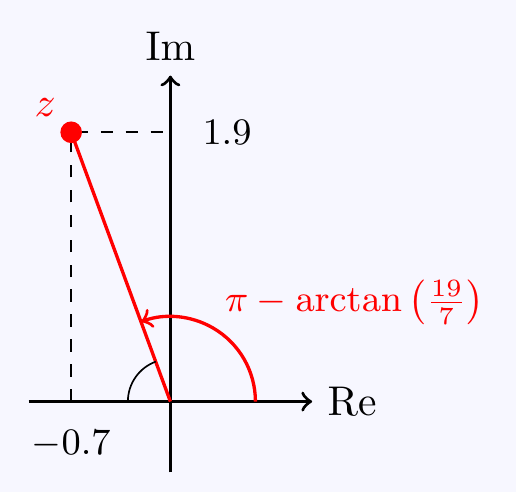
The modulus is \(|1+\sqrt{3}i|=\sqrt{1^2+\left(\sqrt{3}\right)^2}=2\).
Also, \(1+\sqrt{3}i\) is in the upper right quadrant so \(\Arg(1+\sqrt{3}i)=\arctan\left(\dfrac{\sqrt{3}}{1}\right)=\dfrac{\pi}{6}\).
\((b)\;\)
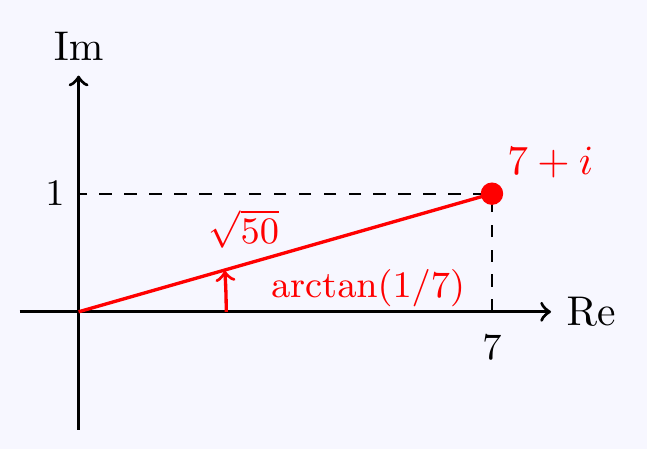
The modulus is \(|3+2i|=\sqrt{3^2+2^2}=\sqrt{13}\).
Also, \(3+2i\) is in the upper right quadrant so \(\Arg(3+2i)=\arctan\left(\dfrac23\right)\).
\((c)\;\)
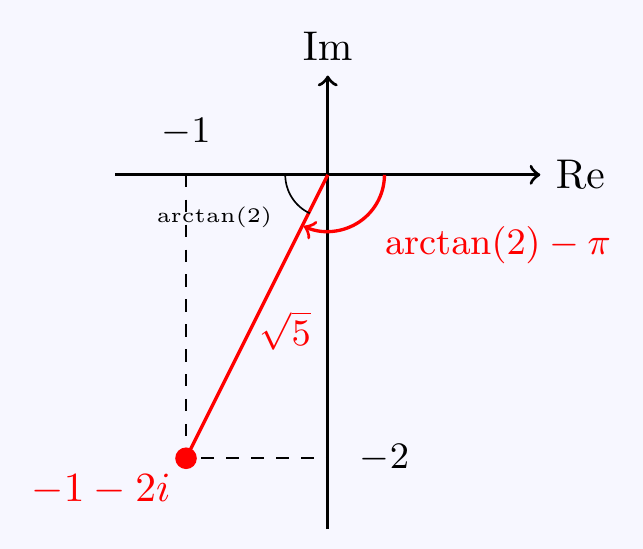
The modulus is \(|-6i|=\sqrt{0^2+(-6)^2}=6\). Also, from the diagram, \(\Arg(-6i)=-\dfrac{\pi}{2}\).
\((d)\;\) First calculate \(z=\dfrac{2+i}{3-i}-\dfrac{4+i}{1+2i}=\dfrac{5+5i}{10}-\dfrac{6-7i}{5}=-0.7+1.9i\).
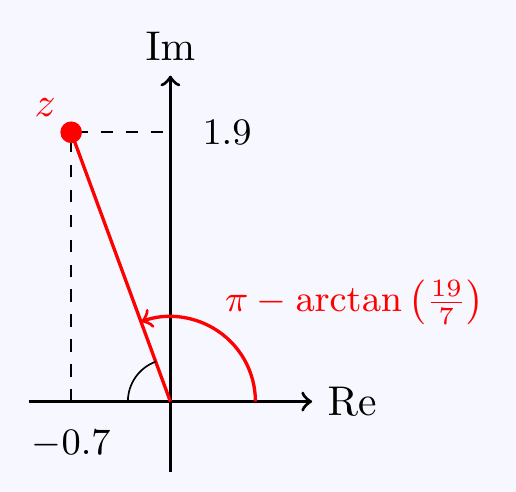
Then \(|z|=\sqrt{0.7^2+1.9^2}=\sqrt{4.1}\). Also, from the diagram, \(\Arg(z)=\pi-\arctan\left(\dfrac{19}{7}\right)\).
\((e)\;\) First calculate \(z=\dfrac{2+3i}{i}-\dfrac{5+10i}{2+i}=\dfrac{5+5i}{10}-\dfrac{6+7i}{5}=7+i\).
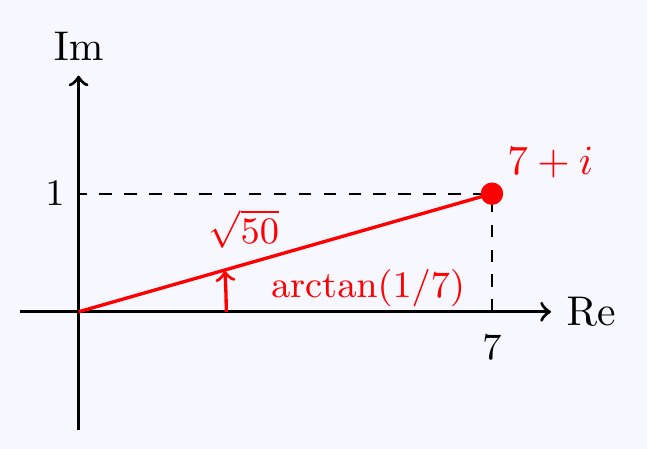
Then \(|z|=\sqrt{7^2+1^2}=\sqrt{50}\). Also, from the diagram, \(\Arg(z)=\arctan\left(\dfrac{1}{7}\right)\).
\((f)\;\) First calculate \(z=\dfrac{3+2i}{1+i}+\dfrac{5-2i}{-1+i}\) \(=\dfrac{5-2i}{2}+\dfrac{-7+3i}{2}=-1-2i\).
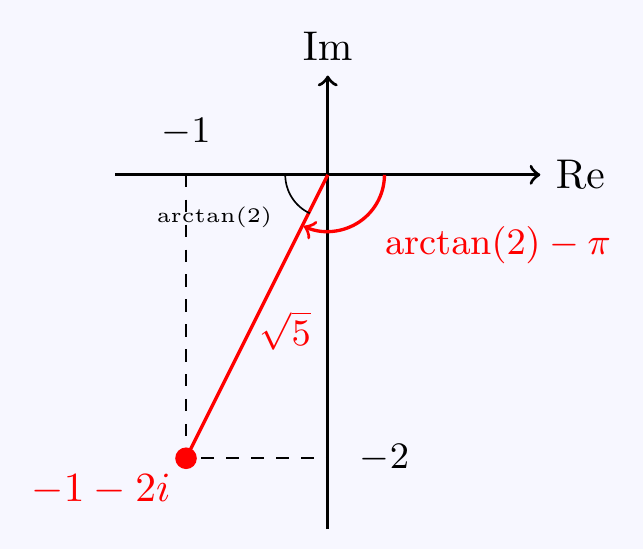
Then \(|z|=\sqrt{1^2+2^2}=\sqrt{5}\). Also, from the diagram, \(\Arg(z)=\arctan(2)-\pi\).
Question 2.5 \(\;\) If \(z_1=1+i\sqrt{3}\) and \(z_2=2+2i\), find the modulus and principal argument of
\(\;\;(a)^*\;\;z_1,\hspace{1.5cm}\) \((b)^*\;\;z_2,\hspace{1.5cm}\) \((c)\;\;\overline{z_1},\hspace{1.5cm}\) \((d)\;\;\overline{z_2},\)
\(\;\;(e)\;\;z_1z_2,\hspace{1cm}\) \((f)^*\;\;z_1/z_2,\hspace{1cm}\) \((g)\;\;z_2/z_1,\hspace{1cm}\) \((h)^*\;\;z_1+z_2.\)
Quick Check
\((a)\;\) Tutorial question
\((b)\;\) Tutorial question
\((c)\;\) \(\displaystyle |\overline{z_1}|=2\qquad\text{and}\qquad \Arg(\overline{z_1})=-\frac{\pi}{3}.\)
\((d)\;\) \(\displaystyle |\overline{z_2}|=2\sqrt{2}\qquad\text{and}\qquad \Arg(\overline{z_2})=-\frac{\pi}{4}.\)
\((e)\;\) \(\displaystyle |z_1z_2|=4\sqrt{2}\qquad\text{and}\qquad \Arg(z_1z_2)=\frac{7\pi}{12}.\)
\((f)\;\) Tutorial question
\((g)\;\) \(\displaystyle \left|\frac{z_2}{z_1}\right|=\sqrt{2}\qquad\text{and}\qquad \Arg\left(\frac{z_2}{z_1}\right)=-\frac{\pi}{12}.\)
\((h)\;\) Tutorial question
Solution
Remember that the “formula” \(\arctan(y/x)\) doesn’t always give the correct angle - it may be out by \(\pm\pi.\) Also, remember the principal argument must be in the range \(-\pi<\theta\leq\pi\). If in doubt, draw a picture!
\((a)\;\) Tutorial question
\(\displaystyle |z_1|=\sqrt{1^2+(\sqrt{3})^2}=2\qquad\text{and}\qquad \Arg(z_1)=\arctan\sqrt{3}=\frac{\pi}{3}.\)
\((b)\;\) Tutorial question
\(\displaystyle |z_2|=\sqrt{2^2+2^2}=2\sqrt{2}\qquad\text{and}\qquad \Arg(z_2)=\arctan\frac{\sqrt{2}}{2}=\frac{\pi}{4}.\)
\((c)\;\) \(\displaystyle |\overline{z_1}|=|z_1|=2\qquad\text{and}\qquad \Arg(\overline{z_1})=-\Arg(z_1)=-\frac{\pi}{3}.\)
\((d)\;\) \(\displaystyle |\overline{z_2}|=|z_2|=2\sqrt{2}\qquad\text{and}\qquad \Arg(\overline{z_2})=-\Arg(z_2)=-\frac{\pi}{4}.\)
\((e)\;\) \(\displaystyle |z_1z_2|=|z_1||z_2|=4\sqrt{2}\qquad\text{and}\qquad \Arg(z_1z_2)=\Arg(z_1)+\Arg(z_2)=\frac{7\pi}{12}.\)
\((f)\;\) Tutorial question
\(\displaystyle \left|\frac{z_1}{z_2}\right|=\frac{|z_1|}{|z_2|}=\frac{\sqrt{2}}{2}\qquad\text{and}\qquad \Arg\left(\frac{z_1}{z_2}\right)=\Arg(z_1)-\Arg(z_2)=\frac{\pi}{12}.\)
\((g)\;\) \(\displaystyle \left|\frac{z_2}{z_1}\right|=\frac{|z_2|}{|z_1|}=\sqrt{2}\qquad\text{and}\qquad \Arg\left(\frac{z_2}{z_1}\right)=\Arg(z_2)-\Arg(z_1)=-\frac{\pi}{12}.\)
\((h)\;\) Tutorial question
We have \(z_1+z_2=3+i(2+\sqrt{3})\) so \[|z_1+z_2|=\sqrt{3^2+(2+\sqrt{3})^2}=2\sqrt{4+\sqrt{3}}\qquad\text{and}\qquad \Arg(z_1+z_2)=\arctan\left(\frac{2+\sqrt{3}}{3}\right).\]
Question 2.6 \(\!{}^*\;\) Which of the following are true for all complex numbers \(z\) and \(w\)? In each case, either prove it is true or give a counterexample.
\(\;\;(a)\;\;\Re(z+w)=\Re(z)+\Re(w),\hspace{1.5cm}\) \((b)\;\;\Re(zw)=\Re(z)\Re(w),\)
\(\;\;(c)\;\;|z+w|=|z|+|w|,\hspace{3.3cm}\) \((d)\;\;\arg(z+w)=\arg(z)+\arg(w).\)
Quick Check
\((a)\;\) True. \(\hspace{1cm}\) \((b)\;\) False. \(\hspace{1cm}\) \((c)\;\) False. \(\hspace{1cm}\) \((d)\;\) False.
Solution
Tutorial question
\((a)\;\) This is true: for \(z=x+iy\), \(w=u+iv\) we have \[\Re(z+w)=\Re\left(x+u+i(y+v)\right)=x+u=\Re(z)+\Re(w).\]
\((b)\;\) This is false: e.g. for \(z=i\), \(w=i\) we have \[\Re(zw)=\Re(-1)=-1\qquad\text{but}\qquad\Re(i)\Re(i)=0\cdot 0 =0.\]
\((c)\;\) This is false: e.g. for \(z=1\), \(w=i\), \[|z+w|=\sqrt{1^2+1^2}=\sqrt{2}\qquad\text{but}\qquad |z|+|w|=1+1=2.\]
\((d)\;\) This is false: e.g. for \(z=1\), \(w=i\), \[\arg(z+w)=\arg(1+i)=\frac{\pi}{4} \qquad\text{but}\qquad \arg(z)+\arg(w)=0+\frac{\pi}{2}=\frac{\pi}{2}.\]
Question 2.7 \(\;\) Suppose \(a\), \(b\) and \(c\) are real numbers with \(b^2<4ac\) and \(z\) is a complex number satisfying \[az^2+bz+c=0.\] Find \(|z|^2=z\overline{z}\) in terms of \(a\), \(b\) and \(c\).
Quick Check
Hint: Use the quadratic formula to find \(z\) and show that \(z\overline{z}=c/a.\)
Solution
The quadratic has two complex conjugate roots \[z,\overline{z}=\frac{-b\pm\sqrt{b^2-4ac}}{2a}=-\frac{b}{2a}\pm i\frac{\sqrt{4ac-b^2}}{2a}\] (Notice \(4ac-b^2>0\) so its square root is real.) Hence \[z\overline{z}=|z|^2=\left(-\frac{b}{2a}\right)^2+\left(\frac{\sqrt{4ac-b^2}}{2a}\right)^2 =\frac{b^2+4ac-b^2}{4a^2}=\frac{c}{a}.\]
Question 2.8 \(\;\) Find the modulus and argument of \(1+i\) and hence find the real and imaginary parts of \((1+i)^{10}\).
Quick Check
Find \(|1+i|=\sqrt2,\;\;\arg(1+i)=\pi/4\) and \(\Re((1+i)^{10})=0,\;\;\Im((1+i)^{10})=32\).
Solution
We have \(|1+i|=\sqrt{1^2+1^2}=\sqrt2\) and \(\arg(1+i)=\arctan(1/1)=\pi/4\) so \(1+i=\sqrt2e^{\pi i/4}\). Hence \[(1+i)^{10}=\left(\sqrt2e^{\pi i/4}\right)^{10}=2^5e^{\frac{10\pi}{4}i} =32e^{\frac{\pi}{2}i}=32\left(\cos\frac{\pi}{2}+i\sin\frac{\pi}{2}\right)=32i\] which has real part \(0\) and imaginary part \(32\).
Week 5 Material
Question 2.9 \(\;\) Find all possible values of
\(\;\;(a)\;\; i^0, \hspace{1cm}\) \(\;\;(b)\;\; i^1, \hspace{1cm}\) \(\;\;(c)\;\; i^i, \hspace{1cm}\) \(\;\;(d)\;\; (1+i)^i, \hspace{1cm}\) \(\;\;(e)^*\;\; (1+i)^{2+i}.\)
Quick Check
\((a)\;\) \(i^0=1\). \(\hspace{1cm}\) \((b)\;\) \(i^1=i\).
\((c)\;\) \(i^i=e^{-\pi/2-2n\pi} \quad\;\;\) for any \(n\in\mathbb{Z}\).
\((d)\;\) \((1+i)^i=e^{-\pi/4-2n\pi+i\ln\sqrt{2}} \quad\;\;\) for any \(n\in\mathbb{Z}\).
\((e)\;\) \((1+i)^{2+i}=2e^{-\pi/4-2n\pi}e^{(\ln{2}+\pi)i/2} \quad\;\;\) for any \(n\in\mathbb{Z}\).
Solution
\((a)\;\) We have \(z^0=1\) for any \(z\neq 0\). So \(i^0=1\).
\((b)\;\) It should be clear that \(i^1=i\).
\((c)\;\) In polar form, \(i=e^{\pi i/2}=e^{\pi i/2+2n\pi i}\) for any \(n\in\mathbb{Z}\). So \[\begin{align*} i^i=\left(e^{\pi i/2+2n\pi i}\right)^i &=e^{\left(\pi i/2+2n\pi i\right)i}\\ &=e^{-\pi/2-2n\pi} \end{align*}\] \(\quad\;\;\) for any \(n\in\mathbb{Z}\).
\((d)\;\) In polar form, \(1+i=\sqrt{2}e^{\pi i/4}=e^{\ln\sqrt{2}+\pi i/4+2n\pi i}\) for any \(n\in\mathbb{Z}\). So \[\begin{align*} (1+i)^i=\left(e^{\ln\sqrt{2}+\pi i/4+2n\pi i}\right)^i &=e^{\left(\ln\sqrt{2}+\pi i/4+2n\pi i\right)i} \\ &=e^{\pi/4-2n\pi+i\ln\sqrt{2}} \end{align*}\] \(\quad\;\;\) for any \(n\in\mathbb{Z}\).
\((e)\;\) Tutorial question
In polar form, \(1+i=\sqrt{2}e^{\pi i/4}=e^{\ln\sqrt{2}+\pi i/4+2n\pi i}\) for any \(n\in\mathbb{Z}\). So \[\begin{align*} (1+i)^{2+i}&=\left(e^{\ln\sqrt{2}+\pi i/4+2n\pi i}\right)^{2+i} =e^{\left(\ln\sqrt{2}+\pi i/4+2n\pi i\right)(2+i)} \\ &=e^{2\ln\sqrt{2}-\pi/4-2n\pi+i\left(\ln\sqrt{2}+\pi/2+4n\pi\right)}\\ &=2e^{-\pi/4-2n\pi}e^{(\ln{2}+\pi)i/2} \end{align*}\] \(\quad\;\;\) for any \(n\in\mathbb{Z}\).
Question 2.10 \(\;\) For each of the following equations, find all complex solutions and plot them on the complex plane.
\(\;\;(a)\;\; z^5-32=0, \hspace{1.7cm}\) \(\;\;(b)\;\; z^5+32=0, \hspace{1.0cm}\) \(\;\;(c)\;\; z^6+8i=0, \hspace{1cm}\)
\(\;\;(d)\;\; z^2+2z+2=0, \hspace{1cm}\) \(\;\;(e)^*\;\; z^6-9z^3+8=0.\)
Quick Check
\((a)\;\) \(z=2e^{2n\pi i/5}=2\left(\cos\dfrac{2n\pi}{5}+i\sin\dfrac{2n\pi}{5}\right)\) for \(n=-2,-1,0,1,2\).
\((b)\;\) \(z=2e^{(2n+1)\pi i/5}= 2\left(\cos\dfrac{(2n+1)\pi}{5}+i\sin\dfrac{(2n+1)\pi}{5}\right)\) for \(n=-2,-1,0,1,2\).
\((c)\;\) \(z=\sqrt{2}e^{(4n-1)\pi i/12}= \sqrt2\left(\cos\dfrac{(4n-1)\pi}{12}+i\sin\dfrac{(4n-1)\pi}{12}\right)\) for \(n=-2,-1,0,1,2\).
\((d)\;\) \(z=-1\pm i\)
\((e)\;\) \(z=e^{2n\pi i/3}, \;2e^{2n\pi i/3} \qquad\text{for $n=-1,0,1$.}\) These six solutions can also be written as \[1,\;\dfrac{-1\pm i\sqrt3}{2}\quad\textrm{and} 2,\; -1\pm i\sqrt3.\]
Solution
\((a)\;\) Write in polar form using \(z=re^{i\theta}\) and \(32=32e^{2n\pi i}\). Then \[\begin{align*} r^5e^{5i\theta}=32e^{2n\pi i} &\qquad\iff\qquad \begin{cases} r^5&=32 \\ 5\theta &=2n\pi \end{cases}\\ &\qquad\iff\qquad \begin{cases} r&=2 \\ \theta &=\frac{2n\pi}{5} \end{cases} \end{align*}\] The solutions are \[z=2e^{2n\pi i/5}=2\left(\cos\dfrac{2n\pi}{5}+i\sin\dfrac{2n\pi}{5}\right)\] for \(n=0,1,2,3,4\). These sit at the vertices of a regular pentagon.
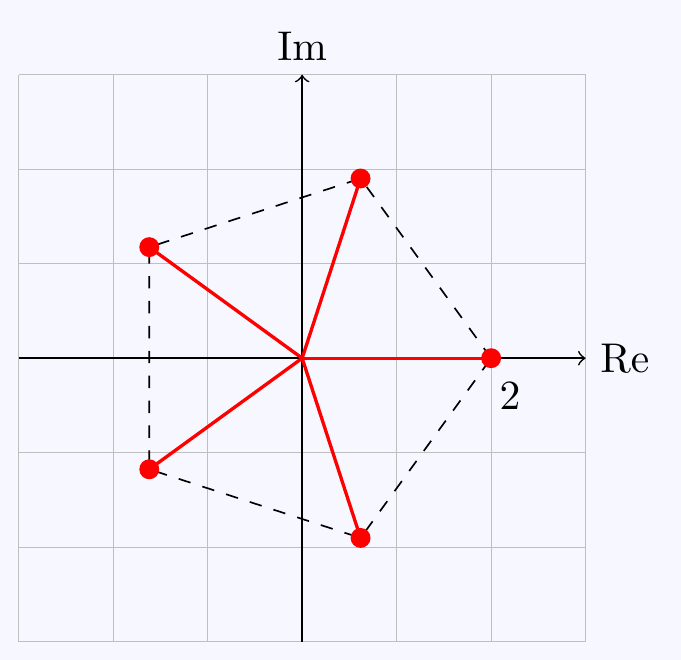
\((b)\;\) Write in polar form using \(z=re^{i\theta}\) and \(-32=32e^{\pi i + 2n\pi i}\). Then \[\begin{align*} r^5e^{5i\theta}=32e^{(2n+1)\pi i} &\qquad\iff\qquad \begin{cases} r^5&=32 \\ 5\theta &=(2n+1)\pi i \end{cases} \\ &\qquad\iff\qquad \begin{cases} r&=2 \\ \theta &=\frac{(2n+1)\pi}{5} \end{cases} \end{align*}\] The solutions are \[z=2e^{(2n+1)\pi i/5}= 2\left(\cos\dfrac{(2n+1)\pi}{5}+i\sin\dfrac{(2n+1)\pi}{5}\right)\] for \(n=0,1,2,3,4\). As in the last question, these sit at the vertices of a regular pentagon.
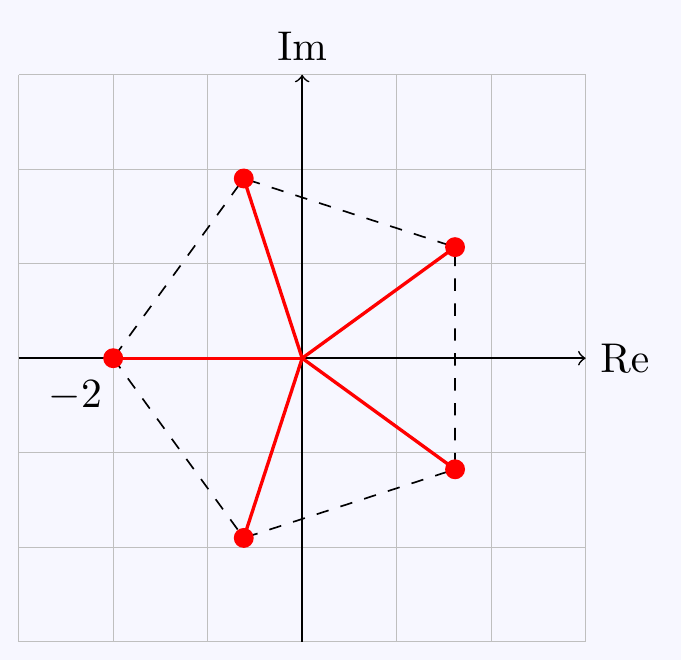
\((c)\;\) Write in polar form using \(z=re^{i\theta}\) and \(-8i=8e^{-\pi i/2 + 2n\pi i}\). Then \[r^6e^{6i\theta}=8e^{(2n-\frac12)\pi i} \quad\iff\quad \begin{cases} r^6\!\!\!&=8 \\ 6\theta\!\!\!&=(2n-\frac12)\pi i \end{cases} \quad\iff\quad \begin{cases} r\!\!\!&=\sqrt{2} \\ \theta\!\!\!&=\dfrac{(4n-1)\pi}{12} \end{cases}\] The solutions are \[z=\sqrt{2}e^{(4n-1)\pi i/12}= \sqrt2\left(\cos\dfrac{(4n-1)\pi}{12}+i\sin\dfrac{(4n-1)\pi}{12}\right)\] for \(n=0,1,2,3,4,5\). This time the solutions form a regular hexagon
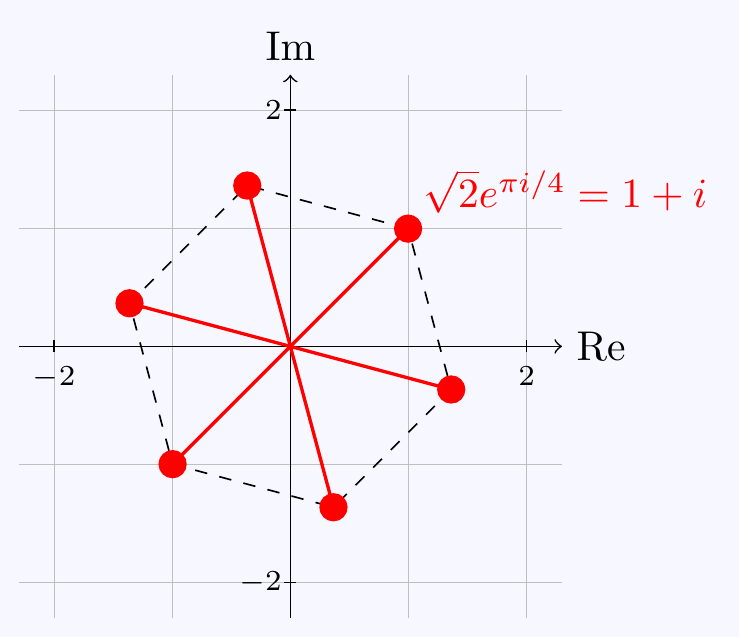
Note, we can sometimes check solutions easily. For example, the solution corresponding to \(n=1\) is \(z=\sqrt{2}e^{\pi i/4}=1+i\) and \[\left(\sqrt{2}e^{\pi i/4}\right)^6=2^{3}e^{3\pi i/2}=-8i\] or alternatively in Cartesian form, \[(1+i)^6=1+6i-15-20i+15+6i-1=-8i.\]
\((d)\;\) We could just use the quadratic formula. Alternatively, by completing the square: \[\begin{align*} z^2+2z+2&=(z+1)^2+1=0 \\ &\iff\quad z=-1\pm i \end{align*}\]
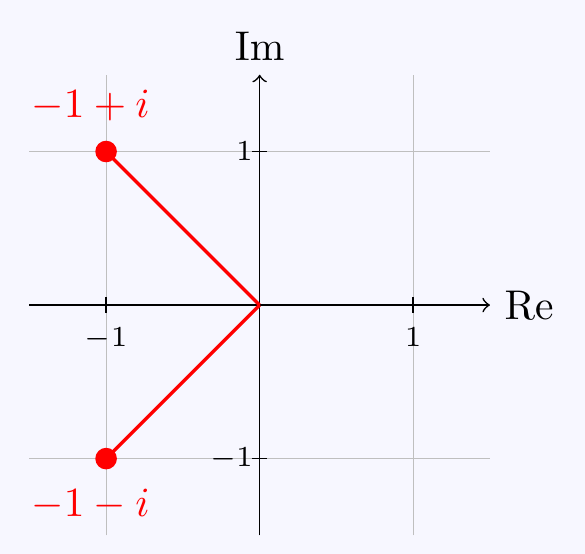
\((e)\;\) Tutorial question
Put \(w=z^3\), then \(w^2-9w+8=(w-8)(w-1)=0\) so \(w=z^3=1\) or \(8\). Solving these two cubic equations gives roots \[z=e^{2n\pi i/3}, \;2e^{2n\pi i/3} \qquad\text{for $n=0,1,2$.}\] These six solutions can be written as \(1\),\(\dfrac{-1+i\sqrt3}{2}\),\(\dfrac{-1-i\sqrt3}{2}\), \(2\), \(-1+i\sqrt3\), \(-1-i\sqrt3\).
They lie at the corners of two equilateral triangles in the complex plane.
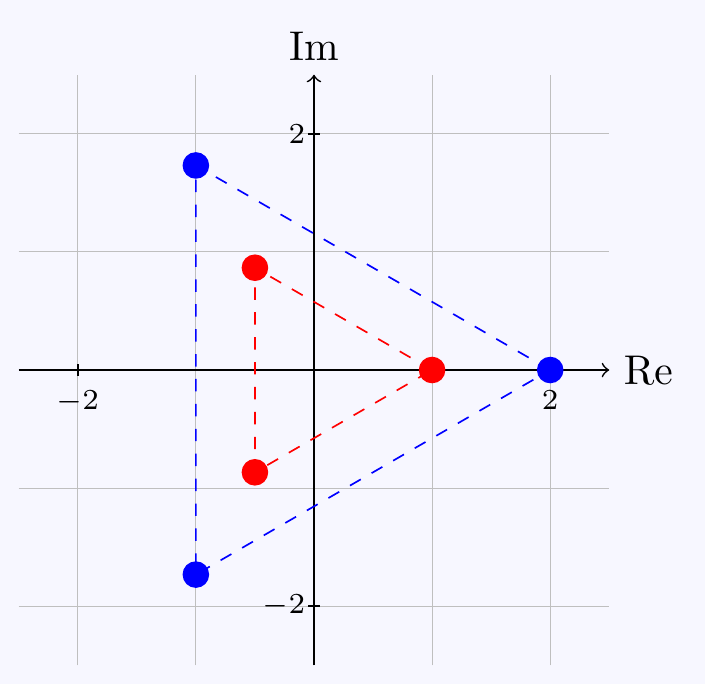
Question 2.11 \(\;\) Let \(P(z)=a_nz^n+a_{n-1}z^{n-1}+...+a_1z+a_0\) be a polynomial with real coefficients \(a_0,a_1,...,a_n\). If \(P(z)=0\), show that \(P(\overline{z})=0\) as well. In other words, a polynomial with real coefficients has roots which are real or occur in pairs of complex conjugates.
Quick Check
Hint: Take complex conjugates of \(P(z)\).
Solution
Consider \(\overline{P(z)}=\overline{0}=0\): since \(a_0,a_1,...,a_n\) are real, they are their own complex conjugates so \[\begin{align*} 0=\overline{P(z)}&=\overline{a_nz^n+a_{n-1}z^{n-1}+...+a_1z+a_0} \\ &=a_n\overline{z^n}+a_{n-1}\overline{z^{n-1}}+...+a_1\overline{z}+a_0 \\ &=a_n\overline{z}^n+a_{n-1}\overline{z}^{n-1}+...+a_1\overline{z}+a_0=P(\overline{z}). \end{align*}\]
Question 2.12 \(\;\) Let \(P(z)=z^4-z^3+z^2+2a\) where \(a\) is a real number and suppose that \(1+i\) is a root of \(P(z)\).
\(\;\;(a)\;\) Using the result of the previous question, find a real quadratic factor of \(P(z)\).
\(\;\;(b)\;\) Use \(P(1+i)=0\) to find the value of \(a\).
\(\;\;(c)\;\) Express \(P(z)\) as a product of two real quadratic factors and hence find all of its roots.
Quick Check
\((a)\;\) \((z-1-i)(z-1+i)=z^2-2z+2\) is a factor.
\((b)\;\) \(a=1.\) \(\hspace{1cm}\) \((c)\;\) The four roots are \(1\pm i\), \(\dfrac{-1\pm i\sqrt3}{2}\).
Solution
\((a)\;\) The coefficients are real so by the previous question, since \(1+i\) is a root so is \(1-i\). Hence \[(z-1-i)(z-1+i)=z^2-2z+2\] is a factor of \(P(z)\).
\((b)\;\) As \((1+i)^2=2i\), \((1+i)^3=-2+2i\), \((1+2i)^4=-4\), \[P(1+i)=-4-(-2+2i)+2i+2a=0\quad\implies\quad a=1.\]
\((c)\;\) Comparing coefficients in \[\begin{align*} P(z)&=z^4-z^3+z^2+2=(z^2-2z+2)(bz^2+cz+d) \\ &=bz^4+(c-2b)z^3+(d-2c+2b)z^2+(2c-2d)z+2d=0 \end{align*}\] shows \(b=c=d=1\), so \[ P(z)=z^4-z^3+z^2+2=(z^2-2z+2)(z^2+z+1)\] Solving the second quadratic as well shows the four roots are \(1\pm i\), \(\dfrac{-1\pm i\sqrt3}{2}\).
Question 2.13 \(\;\;\) Find all complex solutions to the following equations
\(\;\;(a)\;\; e^z=e, \hspace{1cm}\) \(\;\;(b)\;\; e^z=3, \hspace{1cm}\) \(\;\;(c)\;\; e^z=-3,\hspace{1cm}\) \(\;\;(d)\;\; e^z=i.\)
Quick Check
\((a)\;\) \(z=1+2n\pi i\quad\) for \(n\in\mathbb{Z}\). \(\hspace{1cm}\) \((b)\;\) \(z=\ln{3}+2n\pi i\quad\) for \(n\in\mathbb{Z}\).
\((c)\;\) \(z=\ln{3}+(2n+1)\pi i\quad\) for \(n\in\mathbb{Z}\). \(\hspace{1cm}\) \((d)\;\) \(z=\left(\frac{\pi}{2}+2n\pi\right)i\quad\) for \(n\in\mathbb{Z}\).
Solution
\((a)\;\) \[e^{x+iy}=e=e^{1+2n\pi i}\quad\implies\quad x=1,\;y=2n\pi\] and the solutions are \(z=1+2n\pi i\quad\) for \(n\in\mathbb{Z}\).
\((b)\;\) \[e^{x+iy}=3=3e^{2n\pi i}\quad\implies\quad x=\ln{3},\;y=2n\pi\] and the solutions are \(z=\ln{3}+2n\pi i\quad\) for \(n\in\mathbb{Z}\).
\((c)\;\) \[e^{x+iy}=-3=3e^{\pi i+2n\pi i}\quad\implies\quad x=\ln{3},\;y=(2n+1)\pi\] and the solutions are \(z=\ln{3}+(2n+1)\pi i\quad\) for \(n\in\mathbb{Z}\).
\((d)\;\) \[e^{x+iy}=i=e^0e^{\frac{\pi}{2}i+2n\pi i}\quad\implies\quad x=0,\;y=\frac{\pi}{2}+2n\pi\] and the solutions are \(z=\left(\frac{\pi}{2}+2n\pi\right)i\quad\) for \(n\in\mathbb{Z}\).
}
Question 2.14 \(\;\) Find the principal values of the logarithms
\(\;\;(a)\;\; \Ln{e},\hspace{1cm}\) \(\;\;(b)\;\; \Ln{3},\hspace{1cm}\) \(\;\;(c)\;\; \Ln(-3),\hspace{1cm}\) \(\;\;(d)\;\; \Ln{i}.\)
Quick Check
\((a)\;\; 1,\hspace{1cm}\) \((b)\;\; \ln{3},\hspace{1cm}\) \((c)\;\; \ln{3}+\pi i,\hspace{1cm}\) \((d)\;\; \frac{\pi}{2}i\).
Solution
These are the principle values of the solutions in the previous question, i.e. we use the value of \(n\) that makes the imaginary part between \(-\pi\) and \(\pi\).
\((a)\;\;\Ln{e}=1,\hspace{1cm}\) \((b)\;\;\Ln{3}=\ln{3},\hspace{1cm}\) \((c)\;\;\Ln(-3)=\ln{3}+\pi i,\hspace{1cm}\) \((d)\;\;\Ln{i}=\frac{\pi}{2}i\).
Question 2.15 \(\;\) Find all complex numbers \(z\) for which
\(\;\;(a)\;\; \cos{z}=2,\hspace{1cm}\) \(\;\;(b)^*\;\; \sin{z}=-1,\hspace{1cm}\) \(\;\;(c)\;\; \cosh{z}=-2.\hspace{1cm}\)
Quick Check
\((a)\;\) \(z=2n\pi-i\ln(2\pm\sqrt3).\) or \(z=2n\pi\pm i\ln(2+\sqrt3)\qquad\text{for $n\in\mathbb{Z}$.}\)
\((b)\;\) \(z=-\frac{\pi}{2}+2n\pi\qquad\text{for $n\in\mathbb{Z}$.}\)
\((c)\;\) \(z=\ln(2\pm\sqrt3)+(2n+1)\pi i\qquad\text{for $n\in\mathbb{Z}$.}\)
Solution
\((a)\;\) Put into exponential form and rearrange \[\begin{align*} \cos{z}=\frac{e^{iz}+e^{-iz}}{2}=2 &\quad\iff\quad e^{2iz}-4e^{iz}+1=0 \\ &\quad\iff\quad e^{iz}=\frac{4\pm\sqrt{16-4}}{2}=2\pm \sqrt{3}. \end{align*}\]
Now put \(z=x+iy\) and use polar coordinates \(2\pm\sqrt3=(2\pm\sqrt3)e^{2n\pi i}\) for \(n\in\mathbb{Z}\): \[\begin{align*} e^{iz}=2\pm\sqrt3 &\quad\iff\qquad e^{i(x+iy)}=e^{-y}e^{ix}=(2\pm\sqrt3)e^{2n\pi i} \\ &\quad\iff\quad e^{-y}=2\pm\sqrt3\quad\text{and}\quad x=2n\pi \\ &\quad\iff\quad y=-\ln(2\pm\sqrt3)\quad\text{and}\quad x=2n\pi \\ &\quad\iff\quad z=2n\pi-i\ln(2\pm\sqrt3). \end{align*}\]
Actually, since \((2+\sqrt3)(2-\sqrt3)=1\),
we have \(\ln(2+\sqrt3)=-\ln(2-\sqrt3)\) so we could also
write the solutions as
\[z=2n\pi\pm i\ln(2+\sqrt3)\qquad\text{for $n\in\mathbb{Z}$.}\]
\((b)\;\) Tutorial question
This time \[\begin{align*} \sin{z}=\frac{e^{iz}-e^{-iz}}{2i}=-1 &\quad\iff\quad e^{2iz}+2ie^{iz}-1=0 \\ &\quad\iff\quad e^{iz}=\frac{-2i\pm\sqrt{-4+4}}{2}=-i. \end{align*}\] Using \(z=x+iy\) and \(-i=e^{\left(-\frac{\pi}{2}+2n\pi\right)i}\) for \(n\in\mathbb{Z}\), \[\begin{align*} e^{iz}=-i &\quad\iff\quad e^{i(x+iy)}=e^{-y}e^{ix}=e^{\left(-\frac{\pi}{2}+2n\pi\right)i} \\ &\quad\iff\quad e^{-y}=1\quad\text{and}\quad x=-\frac{\pi}{2}+2n\pi \\ &\quad\iff\quad y=0 \quad\text{and}\quad x=-\frac{\pi}{2}+2n\pi \\ &\quad\iff\quad z=-\frac{\pi}{2}+2n\pi\qquad\text{for $n\in\mathbb{Z}$.} \end{align*}\]
\((c)\;\) Now \[\begin{align*} \cosh{z}=\frac{e^z+e^{-z}}{2}=-2 &\quad\iff\quad e^{2z}+4e^{z}+1=0 \\ &\quad\iff\quad e^{z}=\frac{-4\pm\sqrt{16-4}}{2}= -2\pm\sqrt{3}. \end{align*}\] Notice that \(-2\pm\sqrt3<0\) so there are no real solutions. However, we can put \(z=x+iy\) and use \(-2\pm\sqrt3=(2\pm\sqrt3)e^{\pi i +2n\pi i}\) for \(n\in\mathbb{Z}\): \[\begin{align*} e^z=-2\pm\sqrt3 &\quad\iff\quad e^xe^{iy}=(2\pm\sqrt3)e^{\pi i+2n\pi i} \\ &\quad\iff\quad \;x=\ln(2\pm\sqrt3)\quad\text{and}\quad y=(2n+1)\pi \\ &\quad\iff\quad z=\ln(2\pm\sqrt3)+(2n+1)\pi i\qquad\text{for $n\in\mathbb{Z}$.} \end{align*}\]
Question 2.16 \(\;\) For real \(\theta\), use de Moivre’s theorem to express
\(\;\;(a)\;\; \cos(3\theta)\) as a polynomial in \(\cos\theta,\hspace{1cm}\) \(\;\;(b)\;\; \sin(5\theta)\) as a polynomial in \(\sin\theta\).
Quick Check
\((a)\;\) \(\cos(3\theta)=4\cos^3\theta-3\cos\theta.\)
\((b)\;\) \(\sin(5\theta)=16\sin^5\theta-20\sin^3\theta+5\sin\theta.\)
Solution
\((a)\;\) Comparing real parts in \[\begin{align*} \cos(3\theta)+i\sin(3\theta)&=\left(\cos\theta+i\sin\theta\right)^3 \\ &=\cos^3\theta+3i\cos^2\theta\sin\theta-3\cos\theta\sin^2\theta-i\sin^3\theta \end{align*}\] gives \[\begin{align*} \cos(3\theta)&=\cos^3\theta-3\cos\theta\sin^2\theta \\ &=\cos^3\theta-3\cos\theta\left(1-\cos^2\theta\right)\\ &=4\cos^3\theta-3\cos\theta. \end{align*}\]
\((b)\;\) For convenience, write \(c=\cos\theta\), \(s=\sin\theta\). Then by de Moivre’s theorem, we want the imaginary part of \[\begin{align*} \cos(5\theta)+i\sin(5\theta)&=(c+is)^5 \\ &=c^5+5ic^4s-10c^3s^2-10ic^2s^3+5cs^4+is^5, \end{align*}\] that is, \[\begin{align*} \sin(5\theta)&=5c^4s-10c^2s^3+s^5 \\ &=5(1-s^2)^2s-10(1-s^2)s^3+s^5 \\ &=16s^5-20s^3+5s \\ &=16\sin^5\theta-20\sin^3\theta+5\sin\theta. \end{align*}\]
Question 2.17 \(\;\) Show that \(\cos{4\theta}=8\cos^4\theta-8\cos^2\theta+1\) and deduce that \[\cos\frac{\pi}{8}=\frac{1}{2}\sqrt{2+\sqrt2}.\]
Quick Check
Hint: What are the four solutions of \(8c^4-8c^2+1=0\)? Explain why one of these values must be \(\cos(\pi/8)\) and decide which one.
Solution
By de Moivre’s theorem, \[\begin{align*} \cos(4\theta)+i\sin(4\theta)&=\left(\cos\theta+i\sin\theta\right)^4 \\ &=\cos^4\theta+4i\cos^3\theta\sin\theta-6\cos^2\theta\sin^2\theta\\ &\qquad-4i\cos\theta\sin^3\theta +\sin^4\theta \end{align*}\] so comparing real parts and using \(\sin^2\theta=1-\cos^2\theta\) gives \[\begin{align*} \cos(4\theta)&=\cos^4\theta-6\cos^2\theta\sin^2\theta+\sin^4\theta \\ &=\cos^4\theta-6\cos^2\theta\left(1-\cos^2\theta\right)+\left(1-\cos^2\theta\right)^2 \\ &=8\cos^4\theta-8\cos^2\theta+1. \end{align*}\] The degree 4 equation \[8c^4-8c^2+1=0\] has four solutions: in particular, solving as a quadratic in \(c^2\) gives \[c^2=\frac{8\pm\sqrt{8^2-4\times 8}}{16}=\frac{2\pm\sqrt{2}}{4} \quad\implies\quad c=\pm\frac{1}{2}\sqrt{2\pm \sqrt{2}}.\] Furthermore, from the above, if \(\theta\) satisfies \(\cos(4\theta)=0\), then \(c=\cos\theta\) is a solution. That means the four solutions must be \(\cos(\pi/8)\), \(\cos(3\pi/8)\), \(\cos(5\pi/8)\) and \(\cos(7\pi/8)\) in some order.
Finally, since \(\cos(\theta)\) is decreasing for \(0<\theta<\pi\), \(\cos(\pi/8)\) must be the largest i.e. take the positive signs.
Question 2.18 \(\;\) For real \(\theta\), use de Moivre’s theorem to show that
\(\;\;(a)\;\; \cos^3\theta=\dfrac{\cos(3\theta)+3\cos\theta}{4}, \hspace{1cm}\) \(\;\;(b)^*\;\; \cos^4\theta=\dfrac{\cos(4\theta)+4\cos(2\theta)+3}{8}.\)
Quick Check
\((a)\;\) Express \(\cos(3\theta)\) in terms of \(\cos\theta\) and rearrange. Alternatively, expand \(\cos^3\theta=\left(\dfrac{e^{i\theta}+e^{-i\theta}}{2}\right)^3\) and recombine.
\((b)\;\) similar but with \(\sin\).Solution
\((a)\;\) This follows by using Question \(5.8(a)\). Alternatively, using \(\cos\theta=\dfrac{z+z^{-1}}{2}\) where \(z=e^{i\theta}\), \[\begin{align*} \cos^3\theta=\left(\frac{z+z^{-1}}{2}\right)^3 &=\frac18\left(z^3+3z+3z^{-1}+z^{-3}\right) \\ &=\frac14\left(\frac{z^3+z^{-3}}{2}\right) +\frac34\left(\frac{z+z^{-1}}{2}\right) \\ &=\frac{\cos(3\theta)+3\cos\theta}{4}. \end{align*}\]
\((b)\;\) Tutorial question
Similarly, \[\begin{align*} \cos^4\theta=\left(\frac{z+z^{-1}}{2}\right)^4 &=\frac{1}{16}\left(z^4+4z^2+6+4z^{-2}+z^{-4}\right) \\ &=\frac18\left(\frac{z^4+z^{-4}}{2}\right) +\frac12\left(\frac{z+z^{-1}}{2}\right)+\frac38 \\ &=\frac{\cos(4\theta)+4\cos(2\theta)+3}{8}. \end{align*}\]
Question 2.19 \(\;\) For real \(\theta\), use de Moivre’s theorem to express
\(\;\;(a)\;\; \sin^3\theta\) as a combination of \(\sin(3\theta)\) and \(\sin\theta\),
\(\;\;(b)\;\; \sin^4\theta\) as a combination of \(\cos(4\theta)\) and \(\cos(2\theta)\).
Quick Check
\((a)\;\) \(\sin^3(\theta)=\dfrac{3\sin\theta-\sin(3\theta)}{4}\), \(\hspace{1cm}\) \((b)\;\) \(\sin^4(\theta)=\dfrac{\cos(4\theta)-4\cos(2\theta)+3}{8}\).
Solution
\((a)\;\) Using \(\sin\theta=\dfrac{z-z^{-1}}{2i}\) where \(z=e^{i\theta}\), \[\begin{align*} \sin^3\theta=\left(\frac{z-z^{-1}}{2i}\right)^3 &=\frac{1}{-8i}\left(z^3-3z+3z^{-1}-z^{-3}\right) \\ &=\frac34\left(\frac{z-z^{-1}}{2i}\right) -\frac14\left(\frac{z^3-z^{-3}}{2i}\right)\\ &=\frac{3\sin\theta-\sin(3\theta)}{4}. \end{align*}\]
\((b)\;\) Similarly, \[\begin{align*} \sin^4\theta=\left(\frac{z-z^{-1}}{2i}\right)^4 &=\frac{1}{16}\left(z^4-4z^2+6-4z^{-2}+z^{-4}\right) \\ &=\frac18\left(\frac{z^4+z^{-4}}{2}\right) -\frac12\left(\frac{z+z^{-1}}{2}\right)+\frac38 \\ &=\frac{\cos(4\theta)-4\cos(2\theta)+3}{8}. \end{align*}\]
Alternatively, one can expand \(\cos(4\theta)+i\sin(4\theta)=(\cos\theta+i\sin\theta)^4\), etc. and use \(\cos^2\theta+\sin^2\theta=1\) to simplify.
Question 2.20 \(\;\) Given that \[1+z+z^2+z^3+...=\sum_{n=0}^{\infty}z^n=\frac{1}{1-z}\quad\text{for $|z|<1$}\] use de Moivre’s theorem to calculate the following infinite sums for real \(\theta\):
\(\;\;(a)\;\; \displaystyle\sum_{n=0}^{\infty}\left(\frac{1}{2}\right)^n\cos(n\theta),\hspace{1cm}\) \(\;\;(b)\;\; \displaystyle\sum_{n=0}^{\infty}\left(\frac{1}{2}\right)^n\sin(n\theta).\)
Quick Check
Hint: do both at once by using \(e^{in\theta}=\cos(n\theta)+i\sin(n\theta)\).
Then apply the geometric sum with \(z=\dfrac12e^{i\theta}\) and rewrite in terms of \(\cos\) and \(\sin\). You should find
\((a)\;\) \(\dfrac{4-2\cos\theta}{5-4\cos\theta}\), \(\hspace{1cm}\) \((b)\;\) \(\dfrac{2\sin\theta}{5-4\cos\theta}\).
Solution
Parts \((a)\) and \((b)\) are the real and imaginary parts of \[\sum_{n=0}^{\infty}\left(\frac12\right)^ne^{in\theta} =\sum_{n=0}^{\infty}\left(\frac12e^{i\theta}\right)^n =\frac{1}{1-\frac12e^{i\theta}}=\frac{2}{2-e^{i\theta}}\] (This is valid since \(|\frac12e^{i\theta}|=\frac12<1\).) Also, multiplying top and bottom by the conjugate: \[\begin{align*} \frac{2}{2-e^{i\theta}}=\frac{2(2-e^{-i\theta})}{(2-e^{i\theta})(2-e^{-i\theta})} &=\frac{4-2e^{-i\theta}}{4-2e^{i\theta}-2e^{-i\theta}+1} \\ &=\frac{4-2(\cos\theta-i\sin\theta)}{5-4\cos\theta}. \end{align*}\] Hence by taking real and imaginary parts we find
\((a)\;\) \(\displaystyle\sum_{n=0}^{\infty}\left(\frac{1}{2}\right)^n\cos(n\theta)= \frac{4-2\cos\theta}{5-4\cos\theta}\),
\((b)\;\) \(\displaystyle\sum_{n=0}^{\infty}\left(\frac{1}{2}\right)^n\sin(n\theta)= \frac{2\sin\theta}{5-4\cos\theta}\).
Question 2.21 \(\;\) Use the definitions \[\cos{z}=\dfrac{e^{iz}+e^{-iz}}{2} \quad\text{and}\quad \sin{z}=\dfrac{e^{iz}-e^{-iz}}{2i}\] to show that
\(\;\;(a)\;\; \sin(z+w)=\sin{z}\cos{w}+\cos{z}\sin{w},\)
\(\;\;(b)\;\; \cos(z+w)=\cos{z}\cos{w}-\sin{z}\sin{w}.\)
In other words, prove the usual double angle formulae hold for all complex \(z\) and \(w\).
Quick Check
Hint: start from the (more complicated) right-hand sides and simplify.
Solution
\((a)\;\) Start from the (more complicated) right-hand side and simplify \[\begin{align*} \sin{z}\cos{w}+\cos{z}\sin{w}&= \left(\dfrac{e^{iz}-e^{-iz}}{2i}\right)\left(\dfrac{e^{iw}+e^{-iw}}{2}\right) \\ &\qquad\qquad\qquad +\left(\dfrac{e^{iz}+e^{-iz}}{2}\right)\left(\dfrac{e^{iw}-e^{-iw}}{2i}\right) \\ &=\frac{e^{i(z+w)}+e^{i(z-w)}-e^{-i(z-w)}-e^{-i(z+w)}}{4} \\ &\qquad\qquad\qquad +\frac{e^{i(z+w)}-e^{i(z-w)}+e^{-i(z-w)}-e^{-i(z+w)}}{4i} \\ &=\dfrac{e^{i(z+w)}-e^{-i(z+w)}}{2i} \\ &=\sin(z+w). \end{align*}\]
Similarly, \[\begin{align*} \cos{z}\cos{w}-\sin{z}\sin{w}&= \left(\dfrac{e^{iz}+e^{-iz}}{2}\right)\left(\dfrac{e^{iw}+e^{-iw}}{2}\right) \\ &\qquad\qquad\qquad -\left(\dfrac{e^{iz}-e^{-iz}}{2i}\right)\left(\dfrac{e^{iw}-e^{-iw}}{2i}\right) \\ &=\frac{e^{i(z+w)}+e^{i(z-w)}+e^{-i(z-w)}+e^{-i(z+w)}}{4} \\ &\qquad\qquad\qquad+\frac{e^{i(z+w)}-e^{i(z-w)}-e^{-i(z-w)}+e^{-i(z+w)}}{4} \\ &=\dfrac{e^{i(z+w)}+e^{-i(z+w)}}{2} \\ &=\cos(z+w). \end{align*}\]
Question 2.22 \(\;\) Recall the hyperbolic functions: \[\cosh{y}=\dfrac{e^y+e^{-y}}{2} \quad\text{and}\quad \sinh{y}=\dfrac{e^y-e^{-y}}{2}.\] Show that for an arbitrary complex number \(z=x+iy\),
\(\;\;(a)\;\; \sin{z}=\sin{x}\cosh{y}+i\cos{x}\sinh{y},\hspace{1cm}\)
\(\;\;(b)\;\; |\sin{z}|=\sqrt{\sin^2{x}+\sinh^2{y}}\).
Find similar formulae for \(\cos{z}\) and \(|\cos{z}|\).
Quick Check
Hint: start from the (more complicated) right-hand sides and simplify.
Solution
\((a)\;\) One way to do this is to write out the right-hand side in terms of exponentials and then multiply out the brackets, just as in the last question. Alternatively, using the result from the last question, \[\sin(x+iy)=\sin{x}\cos(iy)+\cos{x}\sin(iy)\] and then substitute \[\cos(iy)=\frac{e^{i(iy)}+e^{-i(iy)}}{2}=\frac{e^{-y}+e^{y}}{2}=\cosh{y}\] and \[\sin(iy)=\frac{e^{i(iy)}-e^{-i(iy)}}{2i}=\frac{e^{-y}-e^{y}}{2i} =\frac{-\sinh{y}}{i}=i\sinh{y}.\]
\((b)\;\) Using part \((a)\) we get \[\begin{align*} |\sin(x+iy)|^2&=\sin^2{x}\cosh^2{y}+\cos^2{x}\sinh^2{y} \\ &=\sin^2{x}(1+\sinh^2{y})+(1-\sin^2{x})\sinh^2{y} \\ &=\sin^2{x}+\sinh^2{y} \end{align*}\] and taking square roots (which is okay since all terms are non-negative) gives the result.
Week 6 Material
Question 2.23 \(\;\) Suppose the points \(A\), \(B\), \(C\) and \(D\) represent the complex numbers \(z_1\), \(z_2\), \(z_3\) and \(z_4\) respectively, and \(O\) is the origin \(z=0\).
\(\;\;(a)\;\;\) If \(OABC\) is a parallelogram and \(z_1=1+i\) and \(z_2=4+5i\), find \(z_3\).
\(\;\;(b)\;\;\) If \(ABCD\) is a square, find \(z_2\) and \(z_4\) in the cases
\(\hspace{1.5cm}(i)\;\; z_1=2+i\) and \(z_3=6+7i\hspace{1cm}\) \((ii)\;\; z_1=6-2i\) and \(z_3=6i\).
Quick Check
\((a)\;\) \(z_3=3+4i.\)
\((b)\;(i)\;\) \(z_2=7+2i, \; z_4= 1+6i\) and \(\;\;\;\;(ii)\;\) \(z_2=7+5i, \; z_4=-1-i\).
Solution
\((a)\;\)
The points \(0\), \(z_1\), \(z_2\) and \(z_3\) form a (very thin)
parallelogram when \(z_2=z_1+z_3\) so
\[z_3=(4+5i)-(1+i)=3+4i.\]
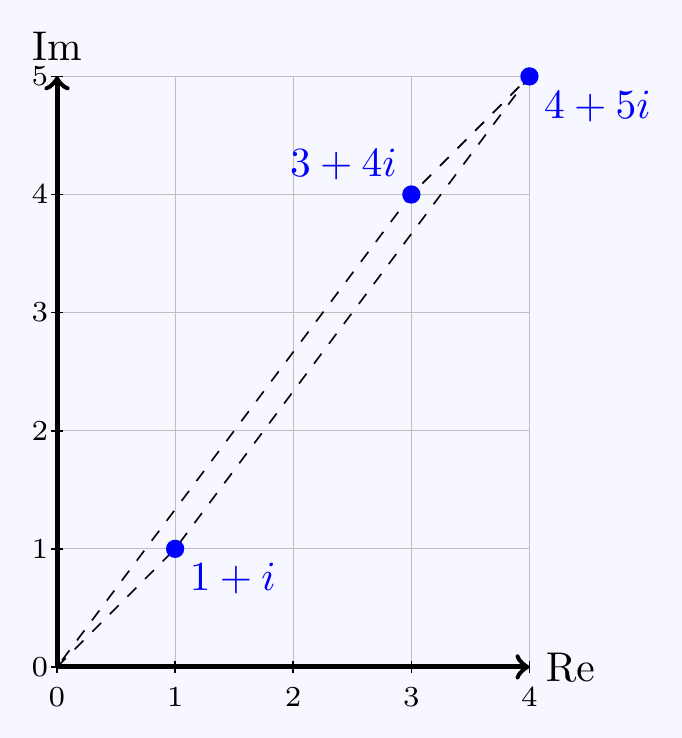
\((b)\;(i)\;\) The centre of the square is the midpoint between \(z_1\) and \(z_3\), i.e \[z_0=\frac{z_1+z_3}{2}=4+4i.\]
We can find the line connecting \(z_2\) and \(z_0\) by rotating the line connecting \(z_1\) to \(z_0\) through an angle \(\pi/2\), i.e. by multiplying by \(e^{\pi i/2}=i\) \[\begin{align*} z_2-z_0&=(z_1-z_0)i \\ \implies\qquad z_2&=z_0+(z_1-z_0)i \\ &=4+4i+(2+i-4-4i)i=7+2i \end{align*}\] Similarly, \[\begin{align*} z_4&=z_0+(z_3-z_0)i \\ &=4+4i+(6+7i-4-4i)i=1+6i \end{align*}\]
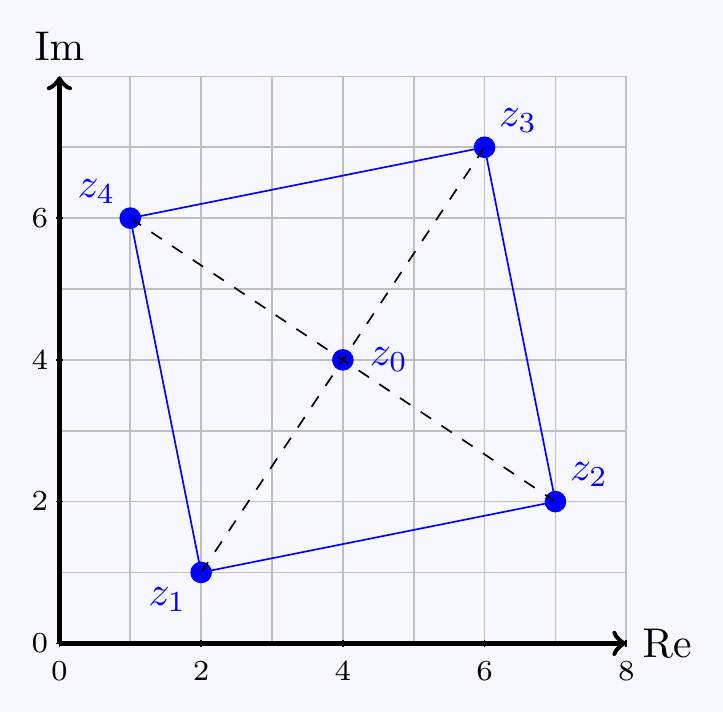
\((b)\;(ii)\;\)
Following the same procedure, we generally get
\[z_2,z_4 = \frac{z_1+z_3}{2}\pm\left(\frac{z_1-z_3}{2}\right)i\]
which in this case gives \(z_2=7+5i\) and \(z_4=-1-i\).
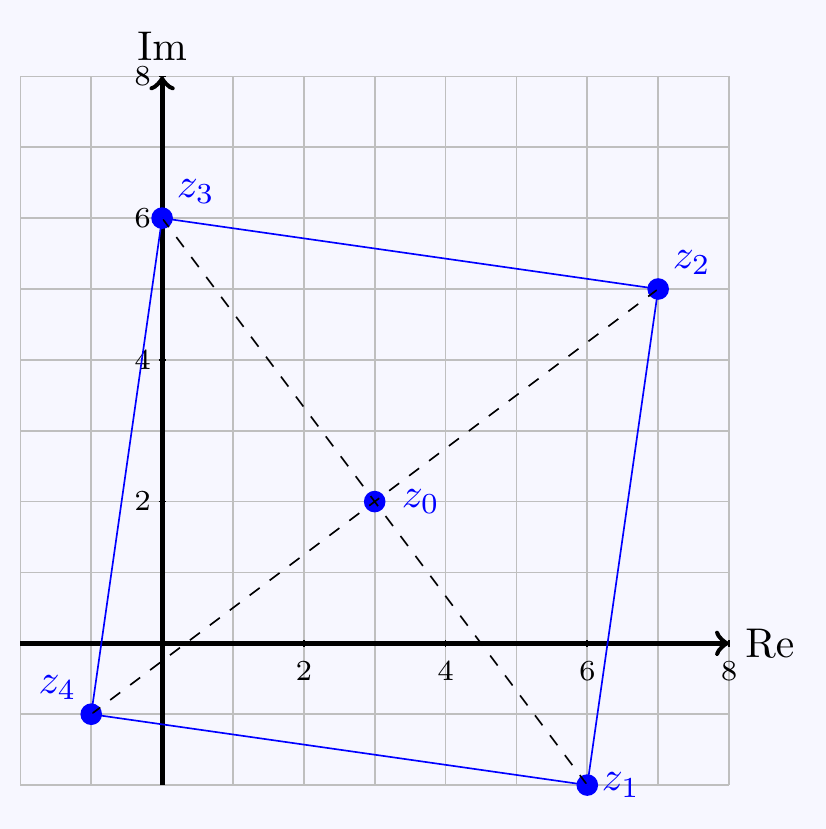
Question 2.24 \(\;\) Three points \(z_1\), \(z_2\) and \(z_3\) form an equilateral triangle in the complex plane. Given that \(z_1=2+i\) and \(z_2=3+i(1+\sqrt{3})\),
\(\;\;(a)\;\;\) Find the modulus and argument of \(z_2-z_1\).
\(\;\;(b)\;\;\) Find the modulus of \(z_3-z_1\).
\(\;\;(c)\;\;\) Find the possible arguments of \(z_3-z_1\).
\(\;\;(d)\;\;\) Hence find the possible values of \(z_3\).
Quick Check
\((a)\;\) \(|z_2-z_1|=2 \quad\text{and}\quad \operatorname{Arg}(z_2-z_1)=\frac{\pi}{3}.\)
\((b)\;\) \(|z_3-z_1|=2\).
\((c)\;\) \(\arg(z_3-z_1)=0 \quad\text{or}\quad 2\pi/3\).
\((d)\;\) \(z_3=4+i\quad\text{or}\quad 1+i(1+\sqrt3)\).
Solution
Notice there will be two choices for \(z_3\) and two possible triangles.
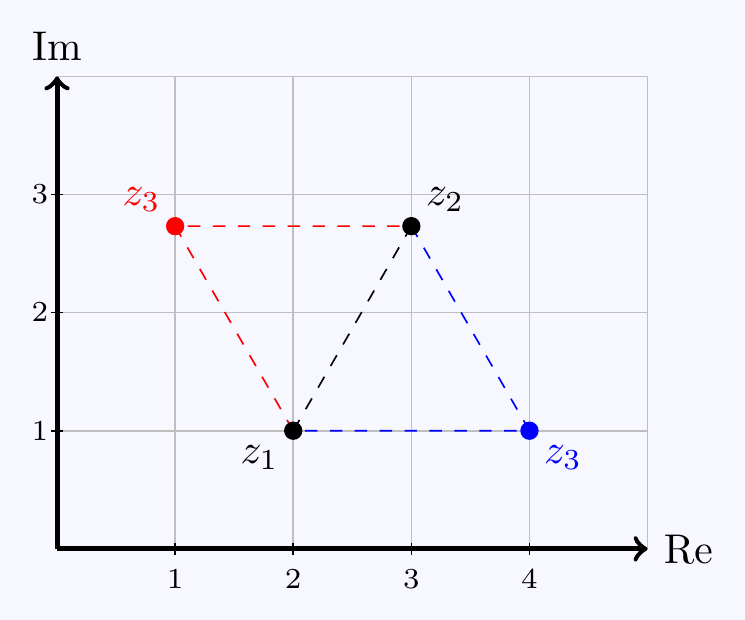
\((a)\;\) As \(z_2-z_1=1+i\sqrt3\), we have \(|z_2-z_1|=\sqrt{1+3}=2\) and \[\Arg(z_2-z_1)=\arctan\left(\dfrac{\sqrt3}{1}\right)=\dfrac{\pi}{3}.\]
\((b)\;\) The side lengths of the triangle are equal so \(|z_3-z_1|=|z_2-z_1|=2\).
\((c)\;\)
The internal angles in an equilateral triangle are \(\pi/3\). We know the edge connecting
\(z_1\) to \(z_2\) makes angle \(\pi/3\) with the real axis. That means the edge connecting \(z_1\)
to \(z_3\) must make angle \(\arg(z_3-z_1)=\pi/3\pm\pi/3=0\) or \(2\pi/3\).
\((d)\;\) Knowing the modulus and argument means we know \(z_3-z_1\) exactly: \[z_3-z_1=2 \quad\text{or}\quad z_3-z_1=2e^{2\pi i/3}=-1+i\sqrt3.\] Hence \(z_3=4+i\quad\text{or}\quad 1+i(1+\sqrt3)\).
Question 2.25 \(\;\) A regular hexagon in the complex plane has centre \(z_0=3+i\) and one of the vertices at \(z_1=3+3i\). Find the other vertices of the hexagon.
Quick Check
The six vertices are \(3 + 3i,\; 3-i, \; 3\pm\sqrt3,\; 3\pm\sqrt3+2i\).
Solution
Call the other vertices \(z_2,...,z_6\). Then the line connecting \(z_{n+1}\) to \(z_0\) is obtained by rotating the line connecting \(z_1\) to \(z_0\) through angle \(n\pi/3\).
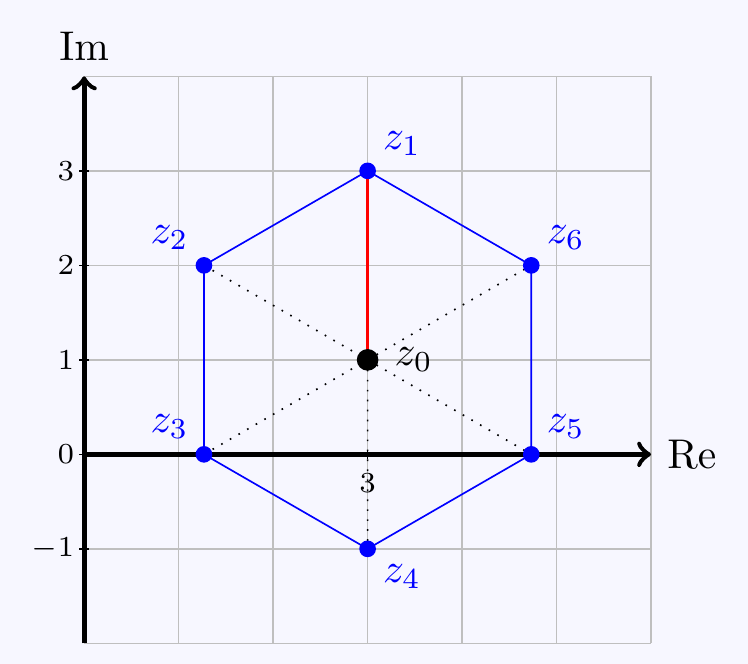
We can find the vertices by multiplying by \(e^{n\pi i/3}\). \[\begin{align*} z_{n+1}-z_0=e^{n\pi i/3}(z_1-z_0) =2ie^{n\pi i/3} \end{align*}\] so \[z_{n+1}=3+i+2ie^{n\pi i/3}.\] Substituting in \(n=0,...,5\) give the six vertices \(3 + 3i,\; 3-i, \; 3\pm\sqrt3,\; 3\pm\sqrt3+2i\).
Question 2.26 \(\;\) Sketch the set of numbers \(z\) in the complex plane satisfying:
\(\;\;(a)\;\;|z|=2,\hspace{3.4cm}\) \(\;\;(b)\;\;|z-2|=|z+2|,\hspace{1.5cm}\) \(\;\;(c)^*\;\;\sqrt{3}\;|z-2|=|z+2|,\)
\(\;\;(d)\;\;|z-2|+|z+2|=6,\hspace{1cm}\) \(\;\;(e)^*\;\;\arg\left(\dfrac{z-2}{z+2}\right)=\dfrac{\pi}{2},\hspace{1cm}\) \(\;\;(f)\;\;\arg\left(\dfrac{z-2}{z+2}\right)=\dfrac{\pi}{4}\).
Quick Check
Hint: Either work geometrically in terms of lengths and angles, or set \(z=x+iy\) and rewrite the conditions in terms of \(x\) and \(y\).
Solution
\((a)\;\) We have \(|x+iy|=2\quad\iff\quad x^2+y^2=4\).
Alternatively, notice \(|z|=2\) is the set of points distance \(2\) from the origin, i.e. it’s a circle.
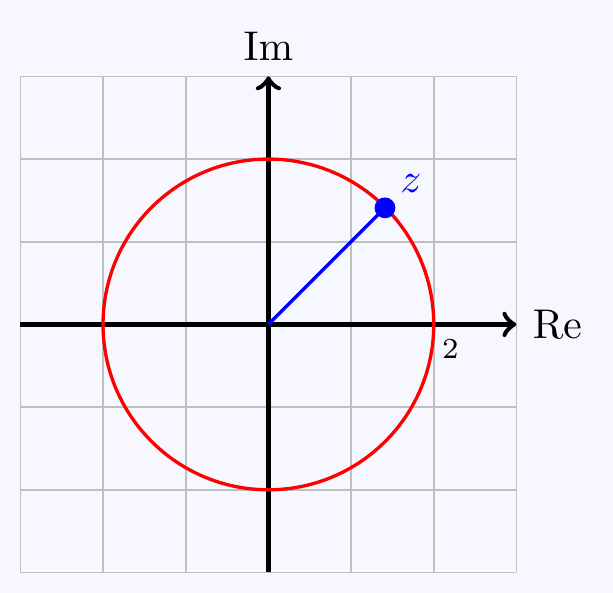
\((b)\;\) We have \((x-2)^2+y^2=(x+2)^2+y^2\quad\iff\quad x=0\).
We can alternatively see that \(|z-2|=|z+2|\) is the set of points equal distance from the point \(2\) and \(-2\). This is the imaginary axis.
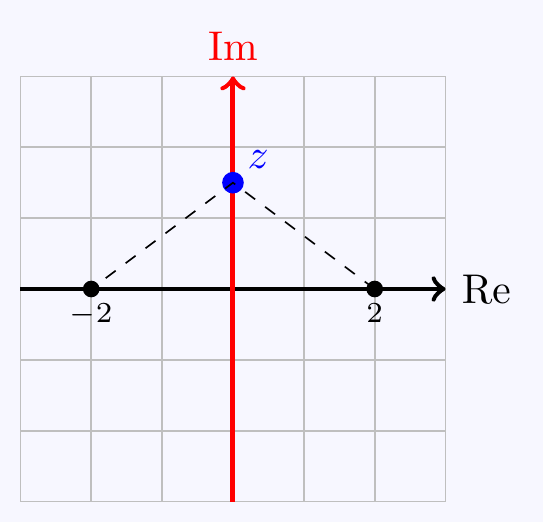
\((c)\;\) Tutorial question
Putting \(z=x+iy\) and squaring gives \[\begin{align*} 3|x+iy-2|^2&=|x+iy+2|^2 \\ \qquad\iff\; 3\left((x-2)^2+y^2\right)&=(x-2)^2+y^2 \\ \qquad\iff\;\, x^2-8x+4+y^2&=0 \\ \qquad\iff\qquad (x-4)^2+y^2&=12 \end{align*}\] which is a circle with centre at \(z=4\) and radius \(\sqrt{12}\).
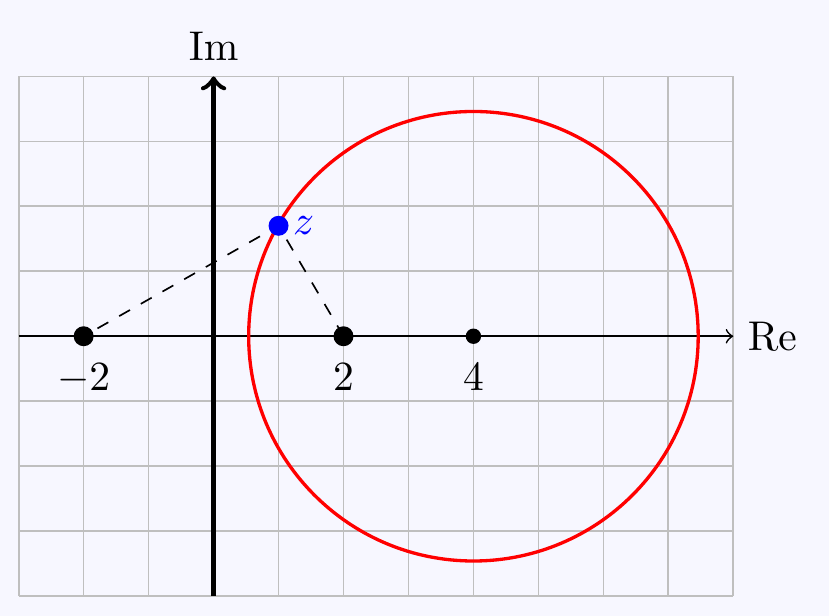
Generalising parts \((b)\) and \((c)\), one can show that the set of points \(z\) with constant ratio of distances \(|z-z_1|/|z-z_2|=c\) is a straight line if \(c=1\) and a circle otherwise.
\((d)\;\) We can do this algebraically (though it’s a bit tedious). Put \(z=x+iy\), then \[|x-2+iy|+|x+2+iy|=6 \qquad\iff\qquad \sqrt{(x-2)^2+y^2}+\sqrt{(x+2)^2+y^2}=6 \] \[\begin{align*} &\qquad\iff\qquad \sqrt{(x-2)^2+y^2}=6-\sqrt{(x+2)^2+y^2} \\ &\qquad\iff\qquad (x-2)^2+y^2=36+(x+2)^2+y^2-12\sqrt{(x+2)^2+y^2} \\ &\qquad\iff\qquad 12\sqrt{(x+2)^2+y^2}=36+(x+2)^2-(x-2)^2=36+8x \\ &\qquad\iff\qquad 3\sqrt{(x+2)^2+y^2}=9+2x \\ &\qquad\iff\qquad 9(x+2)^2+9y^2=81+36x+4x^2 \\ &\qquad\iff\qquad 5x^2+9y^2=45 \\ &\qquad\iff\qquad \bigg(\,\frac{x}{3}\,\bigg)^2+\bigg(\frac{y}{\sqrt5}\bigg)^2=1. \end{align*}\] This is the equation of an ellipse.
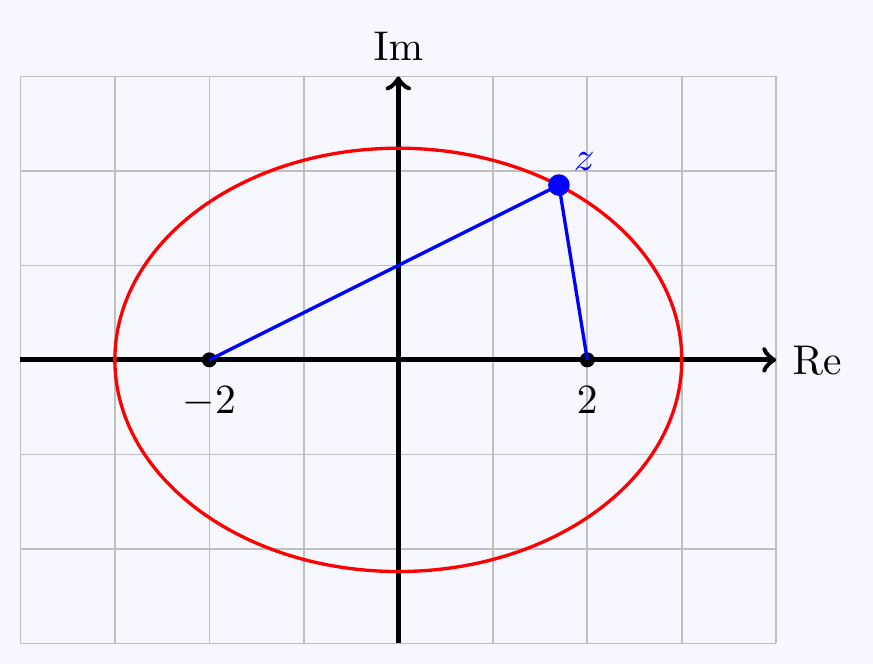
A nice geometric way to see this is if we know the defining property of an ellipse - it’s the set of points with constant sum of distances from two points. That’s exactly what the equation \(|z-2|+|z+2|=6\) says.
\((e)\;\) Tutorial question
Putting \(z=x+iy\), \[\begin{align*} \frac{z-2}{z+2}=\frac{x-2+iy}{x+2+iy}&=\frac{(x-2+iy)(x+2-iy)}{(x+2)^2+y^2}\\ &=\frac{x^2+y^2-4}{(x+2)^2+y^2}+i\frac{4y}{(x+2)^2+y^2} \end{align*}\] so \[\tan\arg\left(\frac{z-2}{z+2}\right)=\frac{4y}{x^2+y^2-4} =\tan\left(\frac{\pi}{2}\right)=\infty.\] We must have \(x^2+y^2-4=0\), i.e. \(z=x+iy\) lies on the circle \(x^2+y^2=4\).
Geometrically, we could see this by looking at the angles in the right-angled triangle shown here.
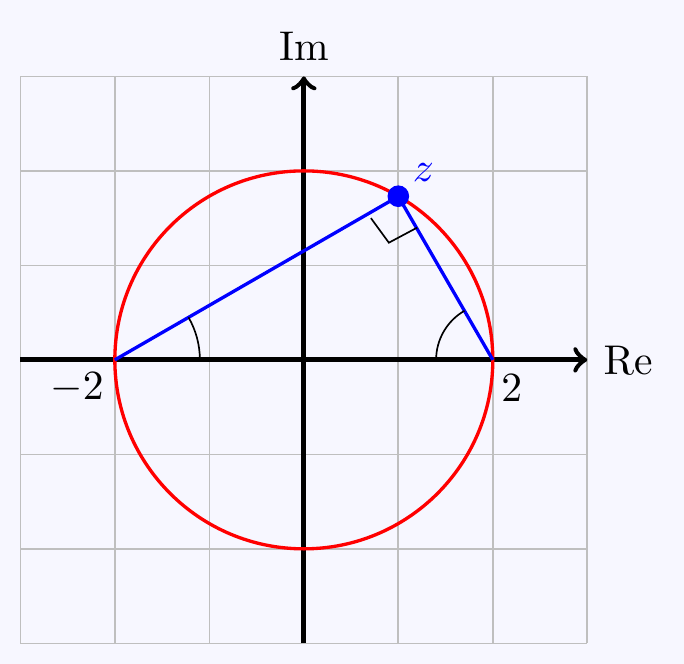
\((f)\;\) We have \[\tan\arg\left(\frac{z-2}{z+2}\right)=\frac{4y}{x^2+y^2-4} =\tan\left(\frac{\pi}{4}\right)=1\] \[\implies\qquad x^2+y^2-4y-4=0\qquad\implies\qquad x^2+(y-2)^2=8\] So \(z=x+iy\) lies on a circle centre \(2i\) and radius \(\sqrt8\).
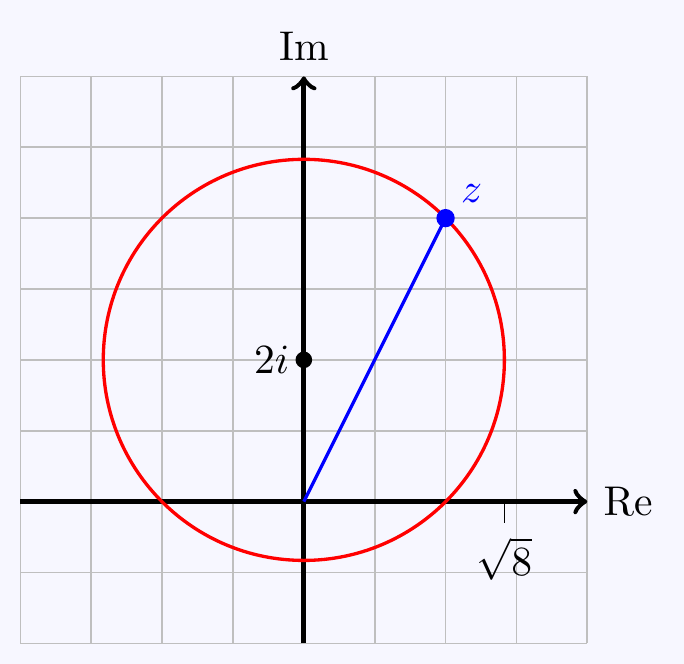
Question 2.27 \(\;\) Find the unique complex number \(z\) satisfying \[|z-1-3i|=|z-1-i|\qquad\text{and}\qquad\Arg(z)=\frac{\pi}{4}.\] (You can do this algebraically, but there is a quick geometric way too.)
Quick Check
You should find \(z=2+2i\).
Solution
Let \(z=x+iy\). Then \[\begin{align*} |z-1-3i|^2=|z-1-i|^2 &\qquad\implies\qquad (x-1)^2+(y-3)^2=(x-1)^2+(y-1)^2 \\ &\qquad\implies\qquad (y-3)^2=(y-1)^2 \\ &\qquad\implies\qquad y^2-6y+9=y^2-2y+1 \quad\implies\quad y=2 \end{align*}\] Also, \(\Arg(z)=\pi/4\) implies \(\arctan(y/x)=\pi/4\) and so \(x=y=2\). We have \(z=2+2i\).
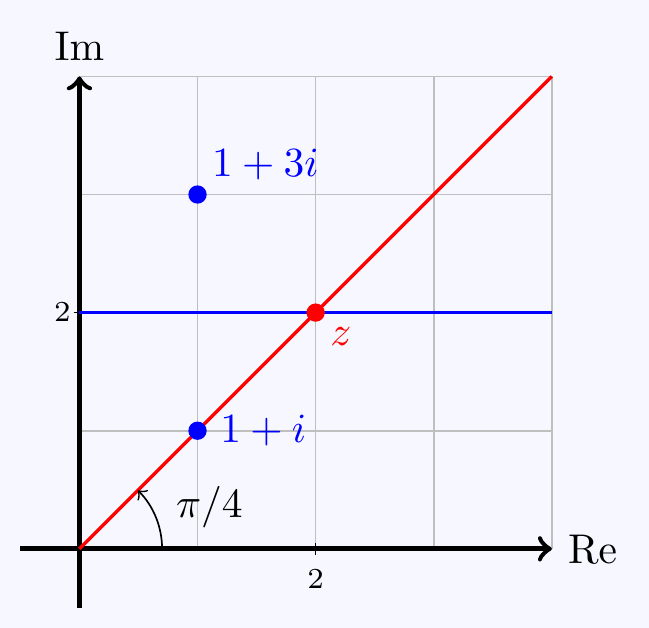
Geometrically, \(\Arg(z)=\pi/4\) means \(z\) makes an angle \(\pi/4\) with the real axis, so \(x=y\).
Also, \(|z-1-3i|=|z-1-i|\) means \(z\) is on the line bisecting \(1+3i\) and \(1+i\), so \(y=2\).
Thus \(z\) is just the intersection of these two lines.
Question 2.28 \(\;\) Describe the sets of complex numbers such that
\(\;\;(a)\;\;\) \(w=(z-i)/(z-1)\) is a real number,
\(\;\;(b)\;\;\) \(w=(z-i)/(z-1)\) is purely imaginary.
\(\;\;\)(Hint: \(w\) is real exactly when \(w=\overline{w}\) and is purely imaginary when \(w=-\overline{w}\).
\(\;\;\) Use this to find a relationship between \(x=\Re(z)=\dfrac{z+\overline{z}}{2}\) and \(y=\Im(z)=\dfrac{z-\overline{z}}{2i}\).)
Quick Check
This is quite difficult, but can be done using the hint and some careful algebra.
Solution
Caution: this one is quite tricky. There are multiple ways to do it, but it can easily turn into a horrible mess of algebra. For both parts, we will use the fact that conjugation respects sums, products and quotients, and so \[\overline{w}=\frac{\overline{z}+i}{\overline{z}-1}.\] We will also use the formulas that express real and imaginary parts using \(z\) and \(\overline{z}\): \[x=\Re(z)=\frac{z+\overline{z}}{2} \quad\text{and}\quad y=\Im(z)=\frac{z-\overline{z}}{2i}.\]
\((a)\;\) We have \(w\) is real precisely when \[\begin{align*} w=\overline{w} &\quad\iff\quad \frac{z-i}{z-1}=\frac{\overline{z}+i}{\overline{z}-1} \\ &\quad\iff\quad (z-i)(\overline{z}-1)=(z-1)(\overline{z}+i) \\ &\quad\iff\quad z\overline{z}-i\overline{z}-z+i=z\overline{z}-\overline{z}+iz-i \\ &\quad\iff\quad i(z+\overline{z})+(z-\overline{z})=2i \\ &\quad\iff\quad \left(\frac{z+\overline{z}}{2}\right)+\left(\frac{z-\overline{z}}{2i}\right)=1 \\ &\quad\iff\quad x+y=1. \end{align*}\] This means that \(z\) lies on the line \(y=1-x\). However, we can’t have \(z=1\) since the fraction \(w\) then doesn’t make sense. Thus the set of points is this line with the point \(z=1\) removed.
\((b)\;\) This time \(w\) is purely imaginary when \[\begin{align*} w=-\overline{w} &\quad\iff\quad \frac{z-i}{z-1}=-\frac{\overline{z}+i}{\overline{z}-1} \\ &\quad\iff\quad (z-i)(\overline{z}-1)=-(z-1)(\overline{z}+i) \\ &\quad\iff\quad z\overline{z}-i\overline{z}-z+i=-z\overline{z}+\overline{z}-iz+i \\ &\quad\iff\quad 2z\overline{z}-(z+\overline{z})+i(z-\overline{z})=0 \\ &\quad\iff\quad z\overline{z}-\left(\frac{z+\overline{z}}{2}\right)-\left(\frac{z-\overline{z}}{2i}\right)=0 \\ &\quad\iff\quad x^2+y^2-x-y=0 \\ &\quad\iff\quad \left(x-\frac12\right)^2+\left(y-\frac12\right)^2=\frac12 \end{align*}\] where in the last step we have completed the squares. This is the equation of a circle in the complex plane with centre at \(\dfrac{1+i}{2}\) and radius \(\dfrac{\sqrt2}{2}\). However, again we can’t have \(z=1\) and so the set of points is this circle with the point \(z=1\) removed.
Question 2.29 \(\;\) In a series RLC circuit, the complex impedance \(Z\) depends on the (real-valued) frequency \(\omega\) via the formula \[Z(\omega)=R+i\omega L+\frac{1}{i\omega C}\] where the capacitance \(C\), inductance \(L\) and resistance \(R\) are real constants.
\(\;\;(a)\;\;\) Find, in terms of \(L\) and \(C\), the resonant frequency of the circuit,
\(\qquad\;\,\) i.e. the frequency \(\omega_0\) at which the impedance \(Z(\omega_0)\) has minimal modulus.
\(\;\;(b)\;\;\) Show that \[\frac{Z(\omega)}{Z(\omega_0)}= 1+iQ\left(\frac{\omega}{\omega_0}-\frac{\omega_0}{\omega}\right)\] \(\qquad\;\,\) for some real constant \(Q\) (this is called the ``\(Q\) factor” of the circuit).
\(\;\;(c)\;\;\) Find, in terms of \(\omega_0\) and \(Q\), the values of \(\omega\) for which the ratio in part \((b)\) has modulus \(\sqrt{2}\).
\(\;\;(d)\;\;\) Given that the complex voltage \(\widehat{V}\) and current \(\widehat{I}\) are related by \(\widehat{V}=\widehat{I}Z(\omega)\), find the
\(\qquad\;\,\) phase difference \(\Arg(\widehat{V})-\Arg(\widehat{I})\) in terms of \(Q\), \(\omega\) and \(\omega_0\).
Quick Check
\((a)\;\) \(\omega_0=\dfrac{1}{\sqrt{LC}}\).
\((b)\;\) You should find \(Q=\dfrac{1}{R}\sqrt{\dfrac{L}{C}}\)
\((c)\;\) \(\omega=\dfrac{\omega_0}{2Q}\left(\pm 1\pm\sqrt{1+4Q^2}\right).\)
\((d)\;\) \(\operatorname{Arg}(V)-\operatorname{Arg}(I)=\arctan\left(Q\left(\dfrac{\omega}{\omega_0}-\dfrac{\omega_0}{\omega}\right)\right).\)
Solution
\((a)\;\) We have \(Z(\omega)=R+i\left(\omega L-\dfrac{1}{\omega C}\right)\) and so \[ |Z(\omega)|^2=R^2+\left(\omega L-\dfrac{1}{\omega C}\right)^2.\] This will be minimal when \(\omega L-\dfrac{1}{\omega C}=0\), i.e. when \(\omega^2=\dfrac{1}{LC}\) and so \(\omega_0=\dfrac{1}{\sqrt{LC}}\).
\((b)\;\) Since \(Z(\omega_0)=R\), we have \[\begin{align*} \frac{Z(\omega)}{Z(\omega_0)} &=1+i\left(\frac{\omega L}{R}-\frac{1}{RC\omega}\right) \\ &=1+i\left(\frac{\omega_0 L}{R}\frac{\omega}{\omega_0}- \frac{1}{\omega_0 RC}\frac{\omega_0}{\omega}\right) \\ &=1+i\left(\frac{1}{R}\sqrt{\frac{L}{C}}\frac{\omega}{\omega_0}- \frac{1}{R}\sqrt{\frac{L}{C}}\frac{\omega_0}{\omega}\right) \\ &=1+iQ\left(\frac{\omega}{\omega_0}-\frac{\omega_0}{\omega}\right) \end{align*}\] where \(Q=\dfrac{1}{R}\sqrt{\dfrac{L}{C}}\).
\((c)\;\) The modulus squared is \(2\), that is, \[\begin{align*} \left|\frac{Z(\omega)}{Z(\omega_0)}\right|^2 &=1+Q^2\left(\frac{\omega}{\omega_0}-\frac{\omega_0}{\omega}\right)^2=2 \\ &\implies\quad Q\left(\frac{\omega}{\omega_0}-\frac{\omega_0}{\omega}\right)=\pm 1 \\[5pt] &\implies\quad Q\omega^2\pm\omega_0\omega-Q\omega_0^2=0 \\ &\implies\quad \omega=\frac{\pm\omega_0\pm\sqrt{\omega_0^2+4Q^2\omega_0^2}}{2Q} =\frac{\omega_0}{2Q}\left(\pm 1\pm\sqrt{1+4Q^2}\right). \end{align*}\]
\((d)\;\) We want to find \[\begin{align*} \Arg(V)-\Arg(I) &=\Arg(V/I) \\ &=\Arg(Z(\omega)) \\ &= \arctan\left(Q\left(\dfrac{\omega}{\omega_0}-\dfrac{\omega_0}{\omega}\right)\right). \end{align*}\]
Question 2.30 \(\!{}^*\;\) In a particular RLC circuit, the complex impedance \(Z\) satisfies \[Z^{-1}=(R+i\omega L)^{-1}+i\omega C\] where the capacitance \(C\), inductance \(L\) and resistance \(R\) are real constants and \(\omega\) is the (real-valued) frequency. Show that \[|Z|^2=\frac{R^2+\omega^2L^2}{(1-CL\omega^2)^2+C^2R^2\omega^2}\] and \[\Arg(Z)=\arctan\left[\frac{\omega}{R}\Big(L-C(R^2+\omega^2L^2)\Big)\right].\]
(Hint: make use of \(|\alpha/\beta|=|\alpha|/|\beta|\), etc.)
Quick Check
Hint: Use the hint or it’s a mess!
Solution
Tutorial question
\[Z^{-1}=\frac{1}{R+i\omega L}+i\omega C= \frac{1+i\omega C(R+i\omega L)}{R+i\omega L}= \frac{\left(1-\omega^2CL\right)+i\omega CR}{R+i\omega L}\] and taking the reciprocal gives \[Z=\frac{R+i\omega L}{\left(1-\omega^2CL\right)+i\omega CR}.\] Hence, by using \(|\alpha/\beta|=|\alpha|/|\beta|\), we get \[|Z|^2=\frac{R^2+\omega^2L^2}{(1-CL\omega^2)^2+C^2R^2\omega^2}.\]
Also, separating \(Z^{-1}\) into real and imaginary parts, \[\begin{align*} Z^{-1}=\frac{1}{R+i\omega L}+i\omega C &=\frac{R-i\omega L}{R^2+\omega^2 L^2}+i\omega C \\ &=\frac{R}{R^2+\omega^2 L^2}- i\frac{\omega\left(L-C(R^2+\omega^2 L^2)\right)}{R^2+\omega^2 L^2}. \end{align*}\] Now using \(\Arg(Z)=-\Arg(Z^{-1})\) gives the required result.